21. THE TROUBLED 21st CENTURY

9/11 ... AND AFGHANISTAN AND IRAQ
CONTENTS
 The American elections of 2000 – Bush The American elections of 2000 – Bush
Jr. takes command in America
 Bush's early programs Bush's early programs
 9/11 (2001) – The cruel hand of Islamic 9/11 (2001) – The cruel hand of Islamic
fundamentalism strikes New York
 The "Bush Doctrine" The "Bush Doctrine"
 The Afghan "Conquest" The Afghan "Conquest"
 Bush decides to take on Saddam's Iraq Bush decides to take on Saddam's Iraq
The textual material on page below is drawn directly from my work
A Moral History of Western Society © 2024, Volume Two, pages 384-389.
THE AMERICAN ELECTIONS of 2000 – BUSH JR. TAKES COMMAND IN AMERICA |
Clinton
had finished out his second presidential term and thus the Democratic
Party turned to his Vice President Al Gore to be their 2000
presidential candidate. On the other side of the aisle, the Republicans
chose the son of the former President Bush (for our purposes in this
narrative identified simply as George Bush, Jr.) to be their candidate.
Both were moderate centrists, close in age (both being early Baby
Boomers ... like Clinton), of similar backgrounds and upbringing.
Unsurprisingly, therefore, the election was fairly respectable ...
until the very end when the vote was so close that recounts were
ordered, in particular in Florida where the vote was very close, and
the state whose electoral vote would decide the close election.
Ultimately the decision went in favor of Bush, Jr. – and Gore
graciously accepted his loss.
Bush, Jr. had been governor of Texas, the only individual to have
actually been reelected to that position up to that point. He
considered himself a "compassionate conservative" ... which in good
Boomer fashion meant almost anything he wanted it to mean. But indeed,
he was focused on upgrading the status of America's Black and Hispanic
minorities ... especially in the realm of early education.
|
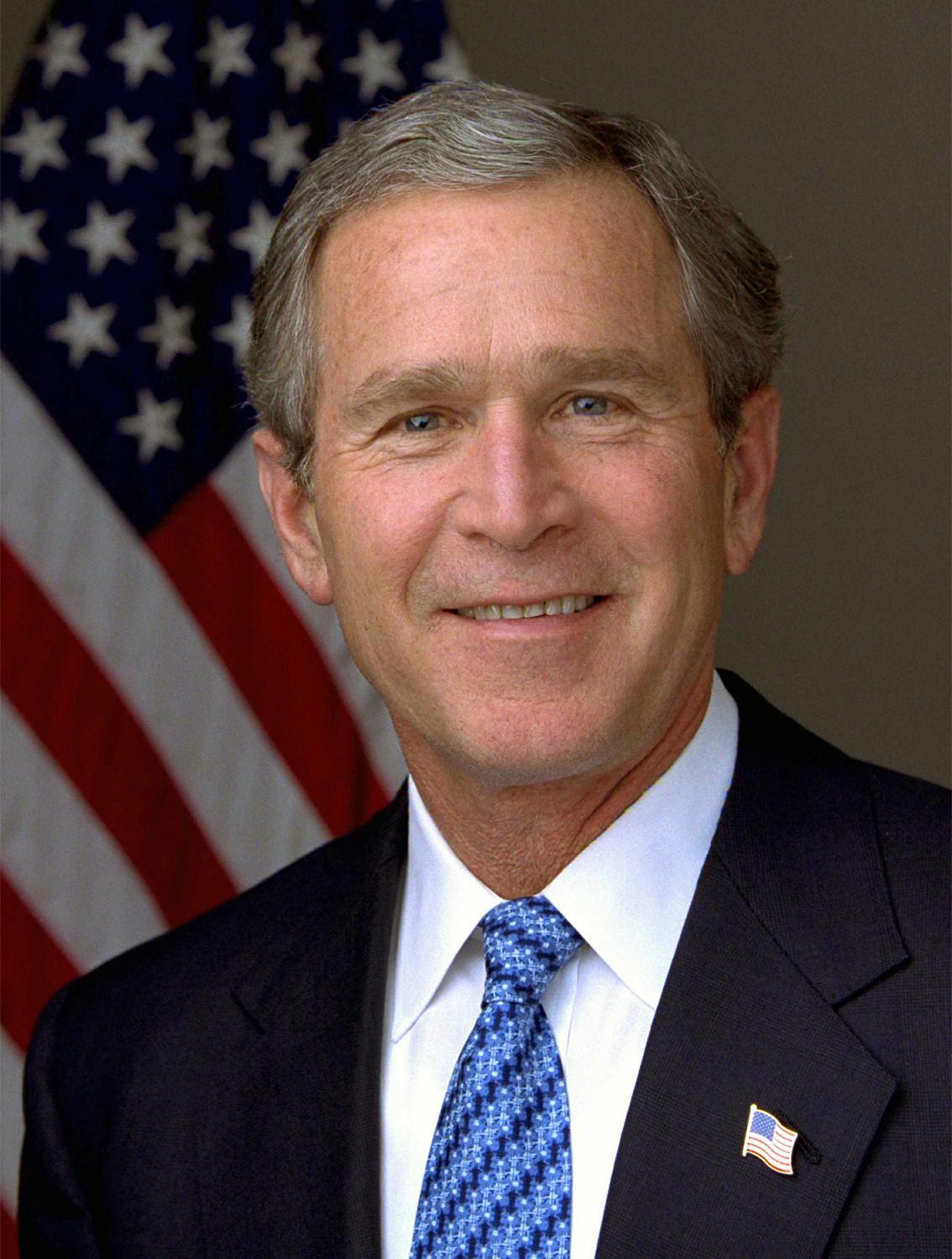
Official photograph portrait
of U.S. President George W. Bush (1946 - )
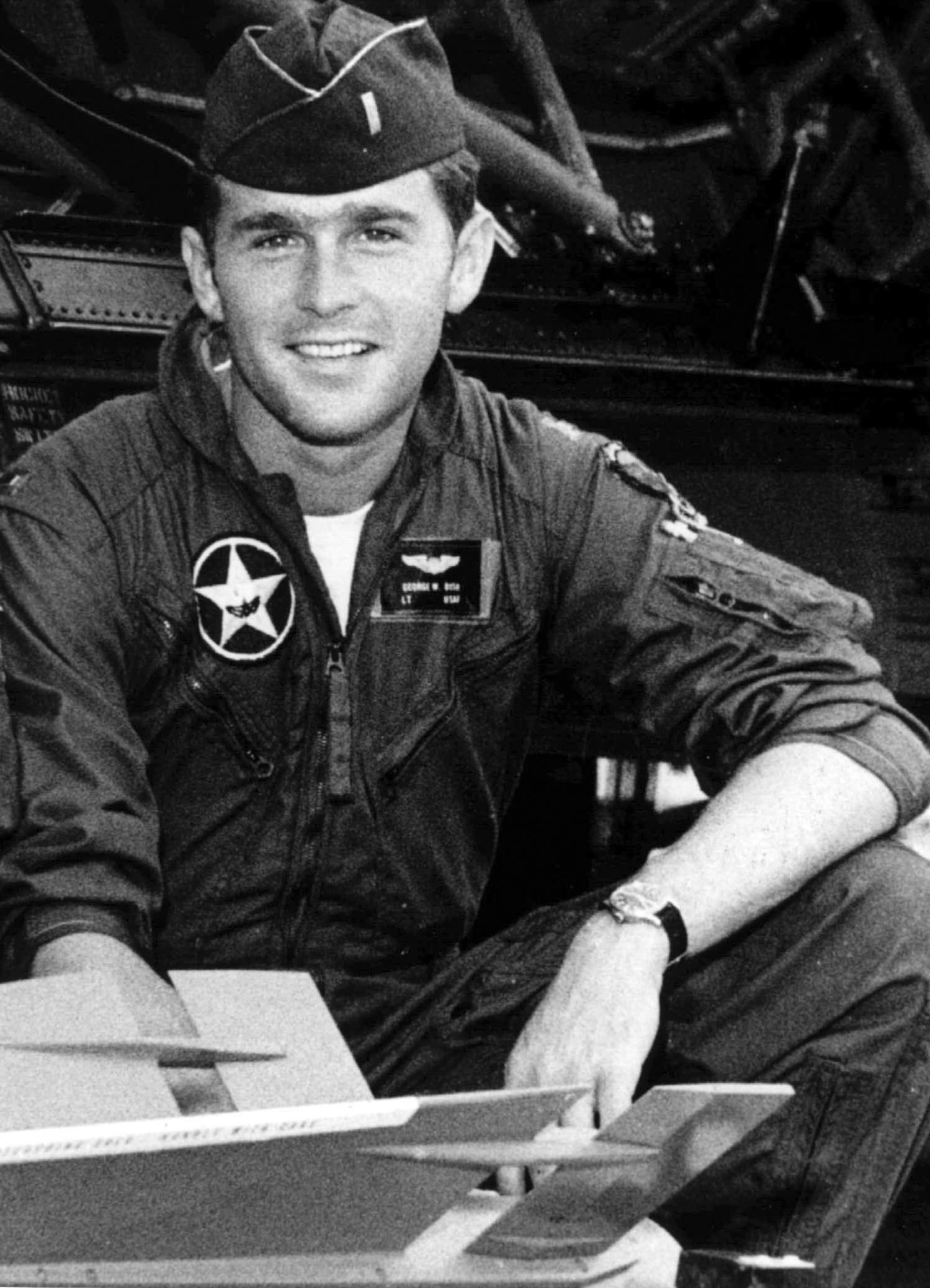
First Lieutenant George W.
Bush in the Texas Air National Guard.
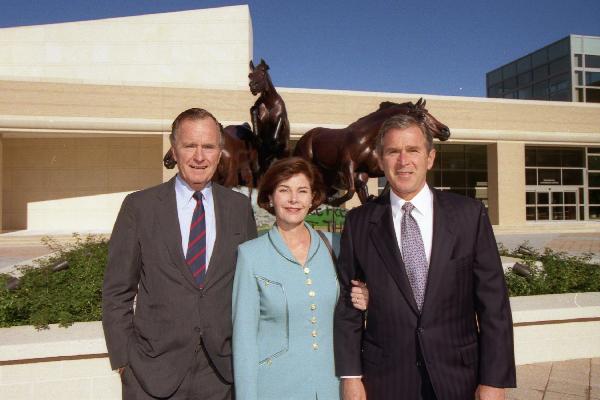
Former President Bush with
son and daughter-in-law, Governor George W. and Laura Bush,
at the George Bush Presidential
Library Dedication in College Station, Texas - 6 November 1997
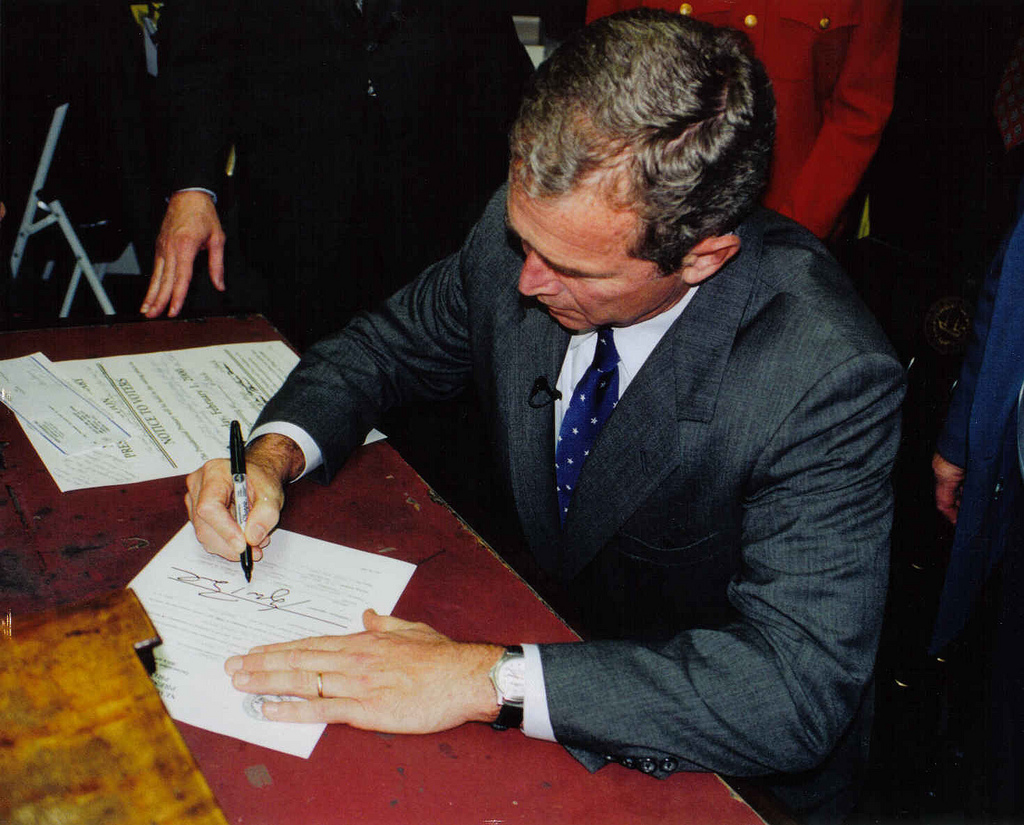
Bush in Concord, New Hampshire
signing to be a candidate for president - 1999
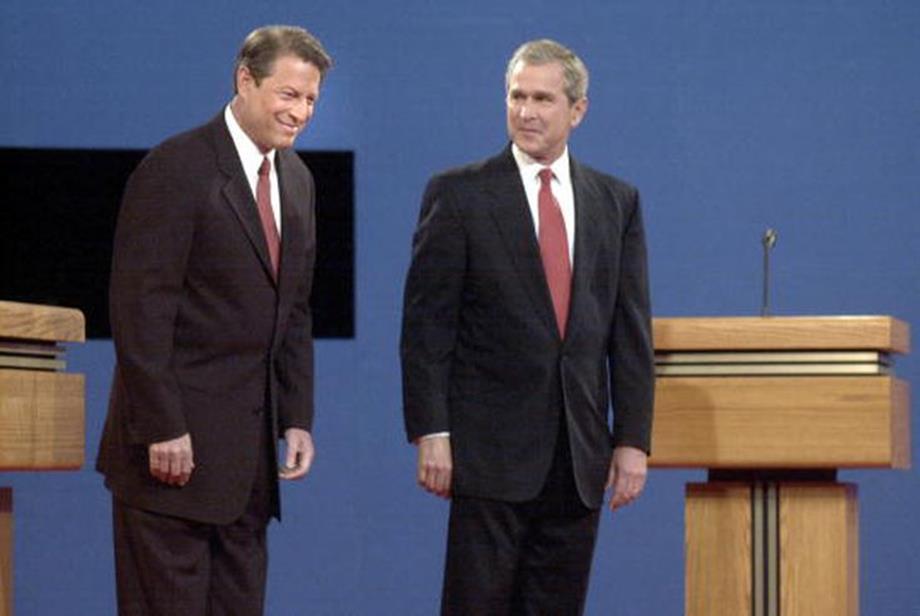
The Bush – Gore presidential debates
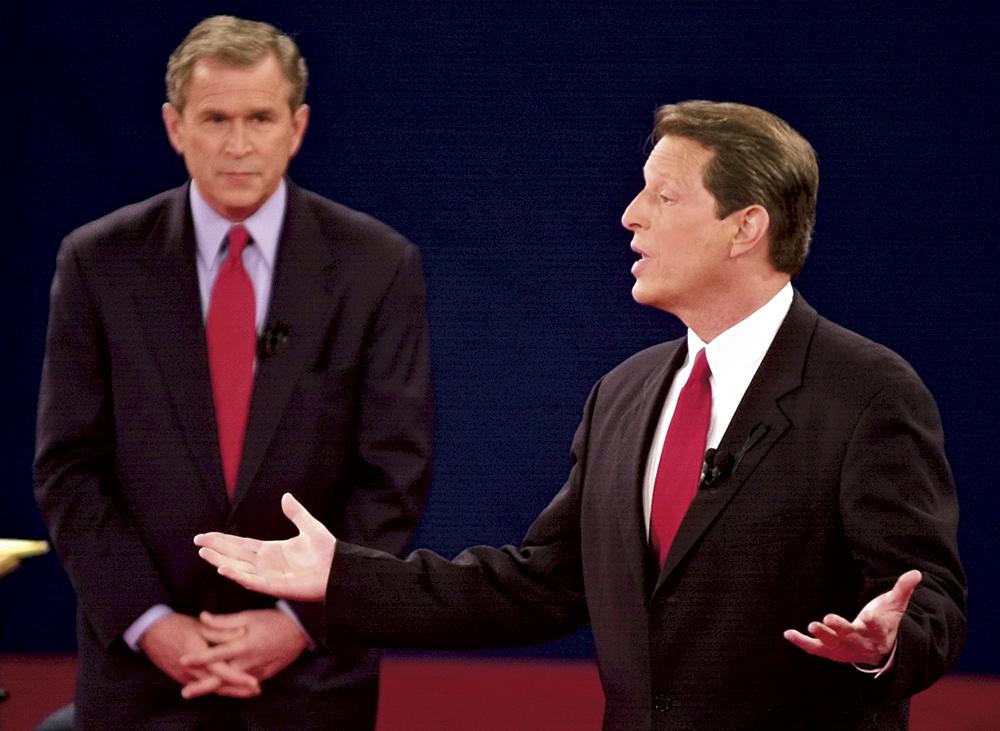
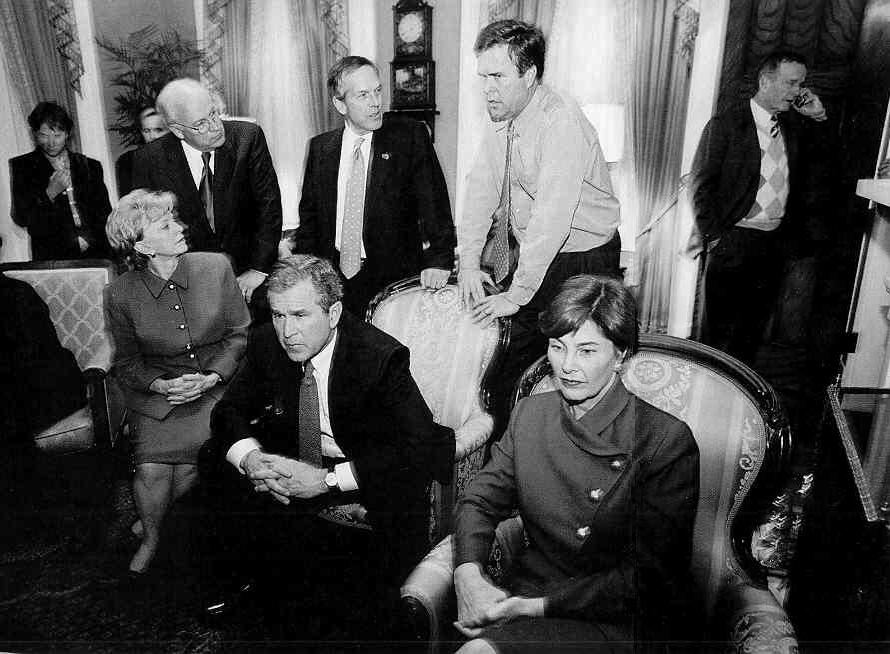
The Bush family awaits the
election returns on election night - November 8, 2000
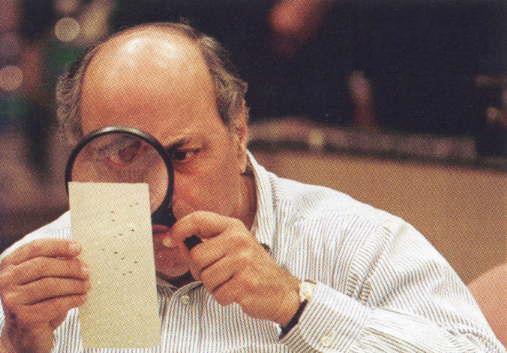
A heated dispute arises over
the closeness of the vote in Florida – and a recount involves the
close inspection of the "chad" ballots
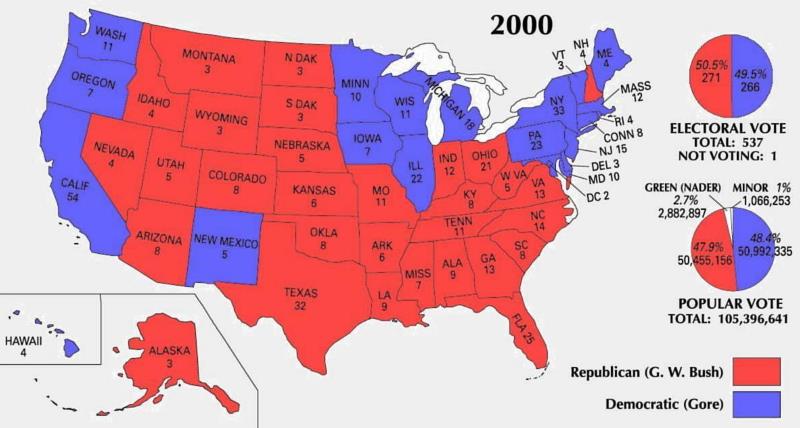 Department of the
Interior
Department of the
Interior
Although Gore
received a slightly
larger popular vote than Bush the 'winner-take all' system of electoral
voting - particularly with the declared win in Florida gave Bush the greater
number of electoral votes. Nader ran as a spoiler - taking away votes
probably wholly from Gore. Thus Bush rather than Gore would be the
nation's next president.
|
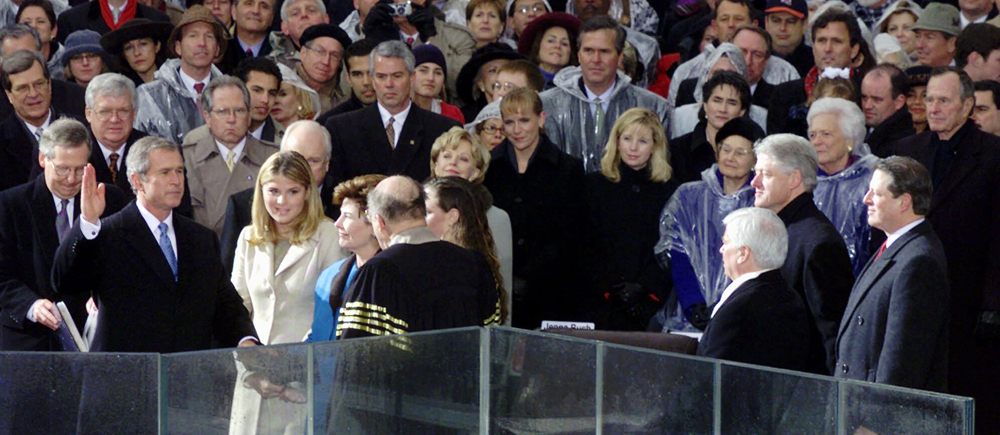
Bush being sworn in as US president - January 21, 2001
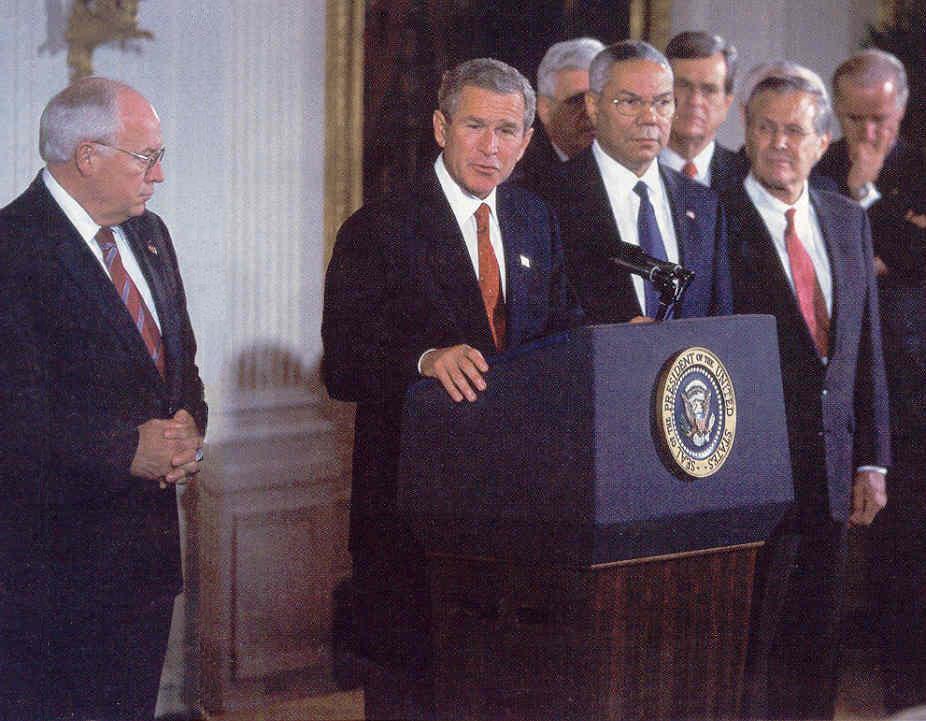
President Bush and part of
his inner team: Vice President Dick Cheney,
the President, Secretary of State Colin Powell,
and Defense Secretary Donald
Rumsfeld
|
Attempts to Get the Economy up and Moving
The Bush tax cut (2001). The Bush presidency got off to a slow start in 2001, in part due to a slowing
economy and due in part to the lack of broad support for one of his key
programs, income tax reduction. His Economic Growth and Tax Relief
Reconciliation Act of (June) 2001 reduced income taxes by $1.3 trillion
(over a ten-year period) across a whole broad spectrum of taxpayers.
The purpose was to leave more money in the hands of the citizen, supposedly
money that would be spent and thus stimulate the economy. But this
tax cut meant that government revenues would fall way below the level of
previous years – adding to the deficit in the federal budget. Nonetheless,
Republicans in both the Senate and the House voted unanimously (one exception
in the Senate) in favor of the bill. The Senate and House Democrats
voted heavily against it, claiming that it merely favored the rich over
the poor.
In part, to
meet criticisms of the
Act, it was designed so that the tax code was not changed permanently.
Rather, all these changes had a "sunset" provision built into them in that
they would terminate at the end of 2010 and the taxes would revert to the
way they were before this 2001 Act (unless Congress voted to renew the
legislation).
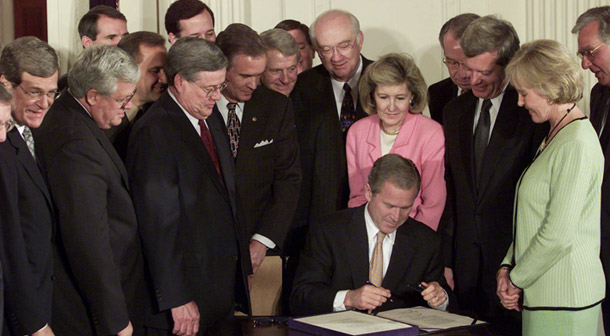 Bush signing the 2001 tax
revision
A second Bush tax revision (2003).
In 2003 a similar Act modified the 2001 Act by increasing or speeding up
the scheduling of the reductions of the 2001 Act (Republicans voting virtually
unanimously in favor; Democrats almost unanimously opposed – with Vice
President Cheney voting to break the tie in favor of passage). With
the war in Afghanistan and Iraq well underway this further reduction in
the federal tax rates only worsened the problem of the rapidly mounting
national debt.
"No Child Left Behind" (NCLB)
Bush: the "Conservative with a Conscience." Another early initiative of the Bush presidency was in the area of
educational
policy – which unlike the tax reduction had extensive bipartisan
support.
Bush declared that Conservatives had consciences and could be just as
compassionate
when it came to the plight of the poor and weak as the Liberals.
He set out to demonstrate this principle with a new federal government
initiative in the field of public education ... when he proposed a bill
to this effect just three days after his inauguration in January of
2001.
In May of 2001 the House (384-45)
and in June the Senate (91-8) passed what was termed the “No Child Left
Behind” Act. President Bush believed that the poor educational
performance of a large number of students and schools across the country
would be greatly improved by requiring each of the states to establish
testing standards, notably in the fields of math and English. Schools
would be expected to undertake reforms to improve those testing scores
or loose state funding.
Federal mandates.
Actually the federal government has no constitutional authority to make
laws or govern in the realm of social policy, including educational policy
– this area being strictly left to the states to administer. But
the federal government gets around this constitutional limitation by pretending
that these are not actually laws, but merely mandates. Technically
mandates are not enforceable laws – except that if states do not comply
with these mandates they likely loose important federal subsidies.
For the states, that can be a big problem. States, unlike the federal
government, are not permitted to cover their operating expenses by running
up a huge government debt. They can operate only as they have actual
funding for their various programs. Most state revenues come from
taxes – a very sensitive issue for the states' voters. Most states
find it difficult to meet expenses, in particular new expenses, through
an increase in taxes. Thus they turn instead to the federal government
for financial assistance.
Unfunded federal mandates.
Of course the federal government has its own financial problems and tries,
just as much as do the states, to avoid new expenses. Thus many of
these mandates that the federal government extends to the states are "unfunded
mandates." This means that the expenses for these federal programs
must be borne by the states themselves, not by the federal government.
If the states did not agree to accept a particular federal mandate then
they would be subject to losing vital federal funding. The NCLB Act
was one of these "unfunded federal mandates."
Republicans and NCLB.
For Republicans to have supported this policy as they did was rather out
of character for them. The NCLB Act clearly increased rather than
decreased the Federal Government’s supervisory role in American
education.
Traditionally, the need to reduce the Federal Government’s role in the
social and economic life of the nation had long been a key doctrine of
the Republican Party. And educational programming coming from
the federal government’s Department of Education had been a particular
target of Republican wrath. According to conservative or traditionalist
Republicans, education had always been – and should always be – left to
the local communities and their school boards, elected by American families,
to decide educational policy. Government bureaucrats enforcing testing
standards (and soon a national standardized curriculum as the focus of
these tests?) of the nation had traditionally been what Republicans viewed
as the path to state socialism and "Big Brother" cultural control of the
nation.
Now Bush had lined up his Republican
support in Congress to vote into place this new measure calling for the
federal supervision of the nation’s educational life ‘in order to improve
American education.’ This seemed to be a policy taken out of
Johnson's Great Society strategy book (indeed the Act received also wide support
of the Democratic Party; in fact Teddy Kennedy co-sponsored the bill in
the Senate).
Was this "compassionate conservatism"?
It certainly wasn't Republican Party principle. Yet Bush wanted this
educational program to be one of the highlights of his
presidency. |
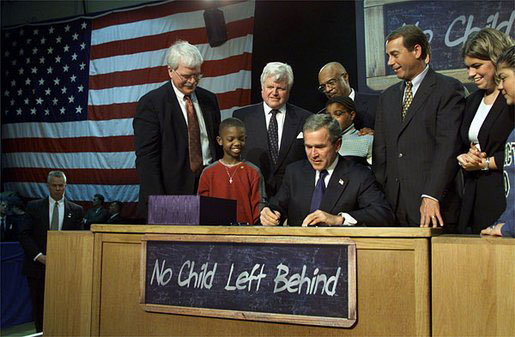
President George W. Bush
signs into law the No Child Left Behind Act - Jan. 8, 2002
|
Visiting Hamilton High School in
Hamilton, Ohio, President George W. Bush signs into law the No Child Left
Behind Act. On hand for the signing are Democratic Rep. George Miller of
California (far left), Democratic U.S. Sen. Edward Kennedy of Massachusetts
(center, left), Secretary of Education Rod Paige (center, behind President
Bush), Republican Rep. John Boehner of Ohio, and Republican Sen. Judd Gregg
of New Hampshire (not pictured). White House photo by Paul Morse. |
THE CRUEL HAND OF ISLAMIC FUNDAMENTALISM STRIKES ON "9/11" (SEPTEMBER 11, 2001) |
In
fact, he was in a Florida classroom publicizing his "No Child Left
Behind" program ... when on the early morning of September 11th, 2001,
he was abruptly informed that a major tragedy had just hit. An airplane
had just crashed into the North Tower of the New York World Trade
Center. And soon another plane did the same to the South Tower,
confirming the suspicion that this was not just some horrible aerial
accident. Then a third plane hit the Pentagon building in D.C. And a
fourth plane was found to have been brought down in rural Pennsylvania
by some of its passengers when news reached them of what had just
happened ... and they realized that the Arab pirates who had just taken
over their plane were heading it also to D.C. – with the most probably
intention of hitting either the White House or the Capitol Building.
All in all, the actions of these suicide pirates ended up killing some
2,800 people (office workers, firemen and police called to the sites,
airplane passengers, and others) and wounding many more ... in fact
wounding deeply the heart of America – as well as the hearts of other
nations who also lost nationals in the event ... or simply felt a deep
hurt for what they knew their fellow Americans had just gone through.
However, many in the Muslim world were shockingly a strong exception to
this spirit of sympathy – for they saw the event as something to be
celebrated.
And once again, it took very little time to figure out who the actual
culprits were: local members of al-Qaeda – some 24 of them (five each
to a plane, except one who was missing).
|
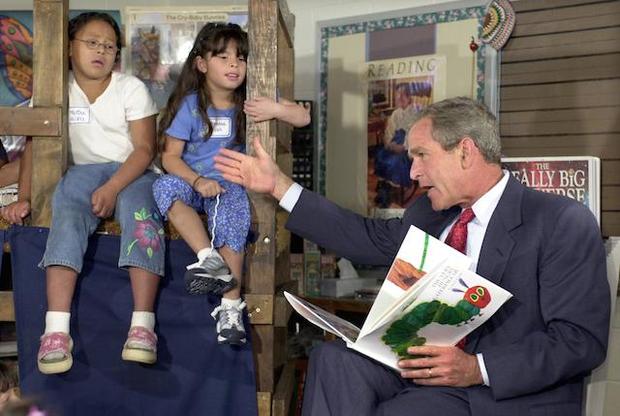
September 11, 2001 - Bush reading to
elementary students as part of his effort to promote 'No Child Left
Behind'
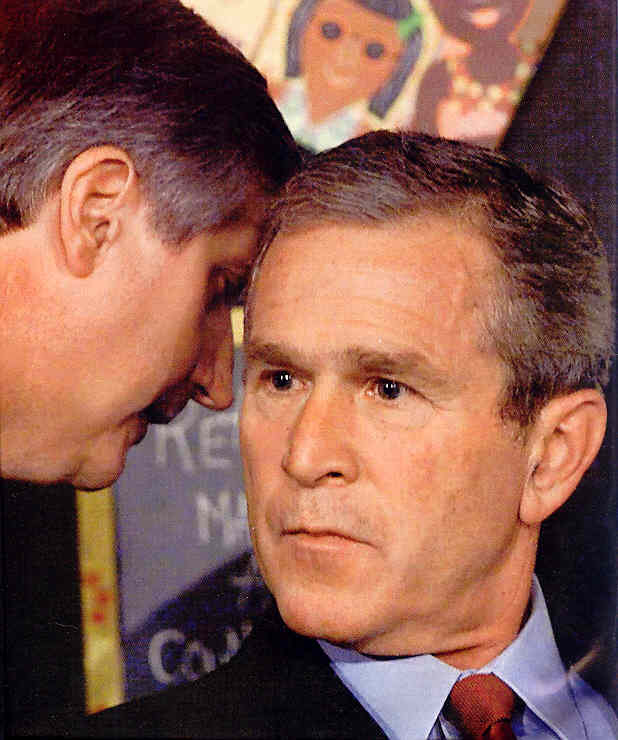 Pres. Bush being informed
by Chief of Staff Andy Card of the WTC tragedy
Pres. Bush being informed
by Chief of Staff Andy Card of the WTC tragedy
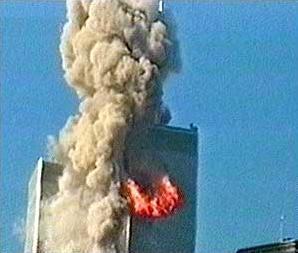
8:46 a.m. - American Flight
11 hits the North Tower
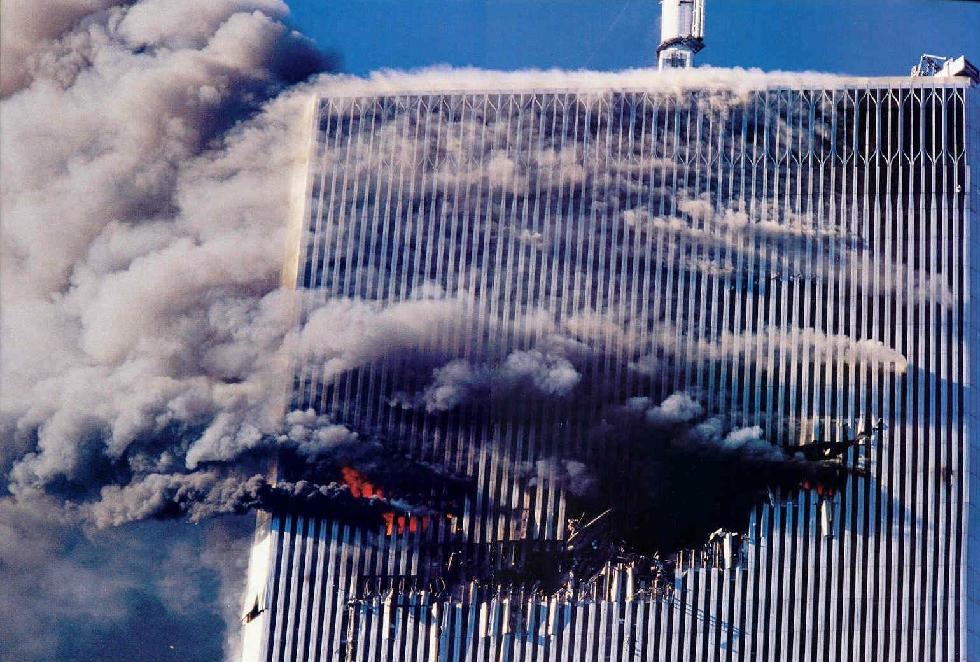
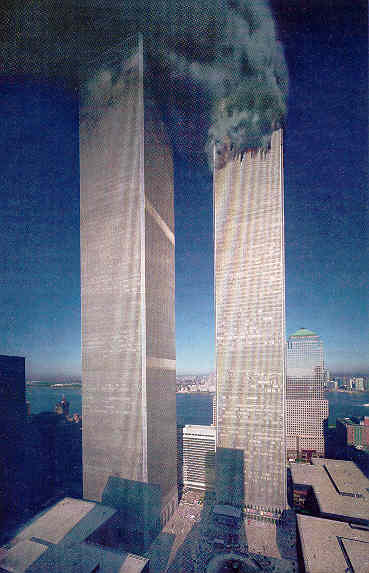
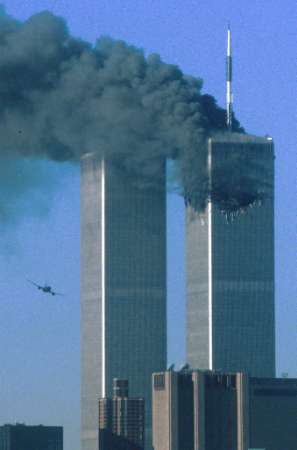 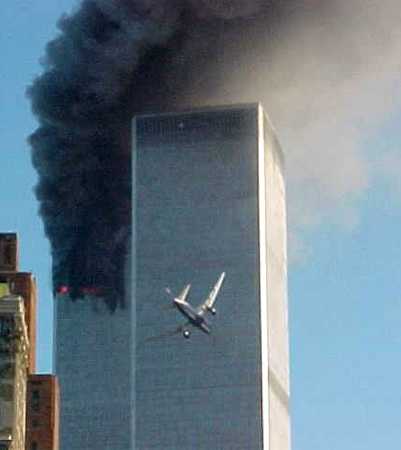
9:03 a.m. - United Flight
175 heads into the South Tower
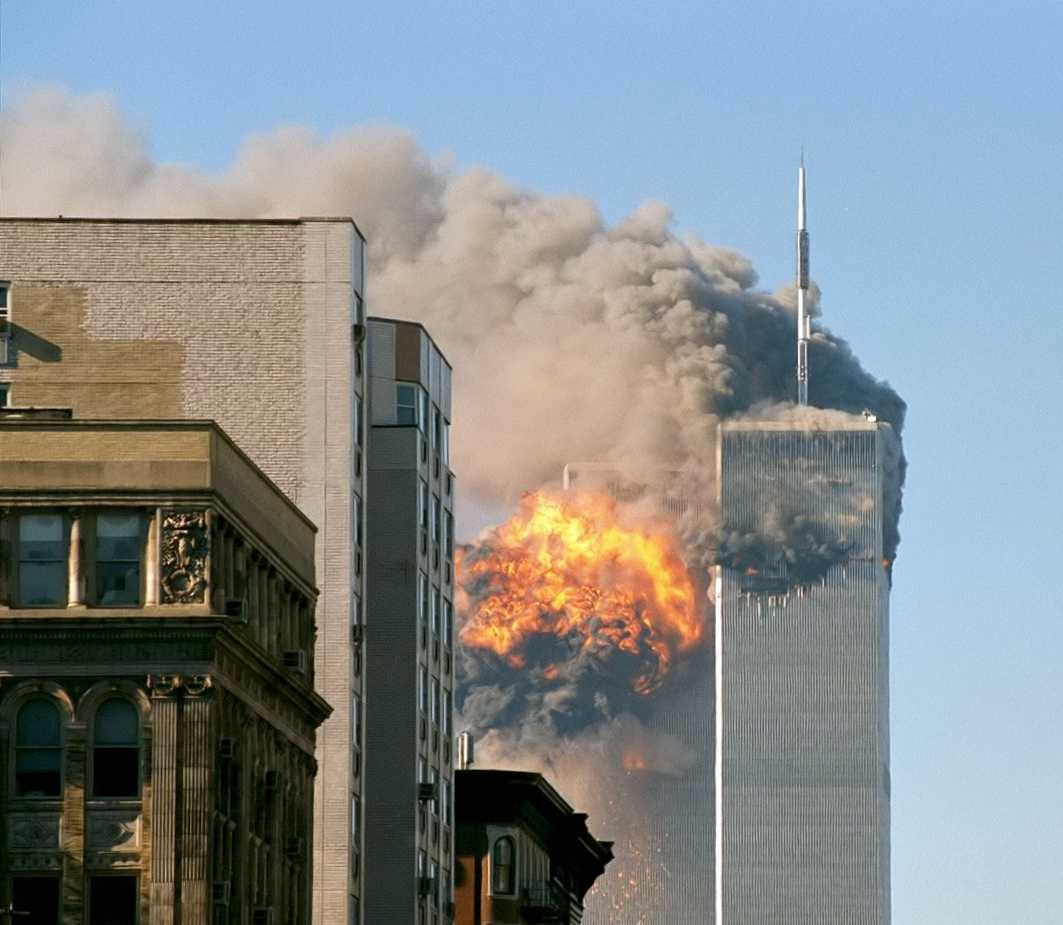
United Airlines Flight 175
crashes into the south tower of the World Trade Center
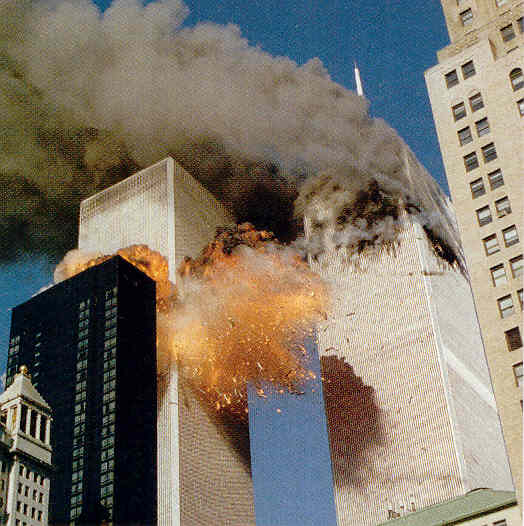
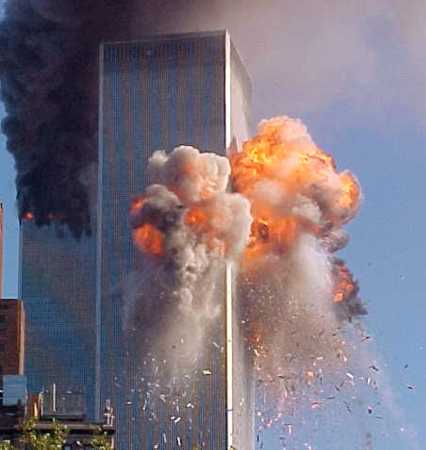
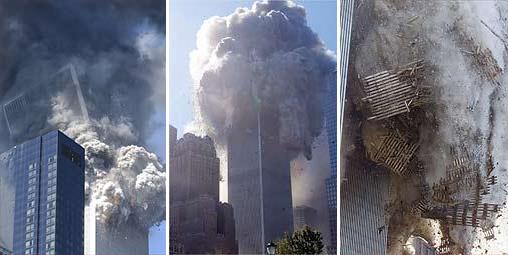 10:05 - the South Tower
collapses 10:05 - the South Tower
collapses
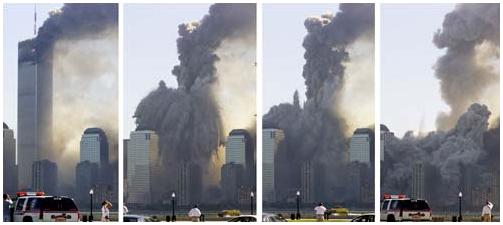 10:28 - the North Tower
collapses
10:28 - the North Tower
collapses
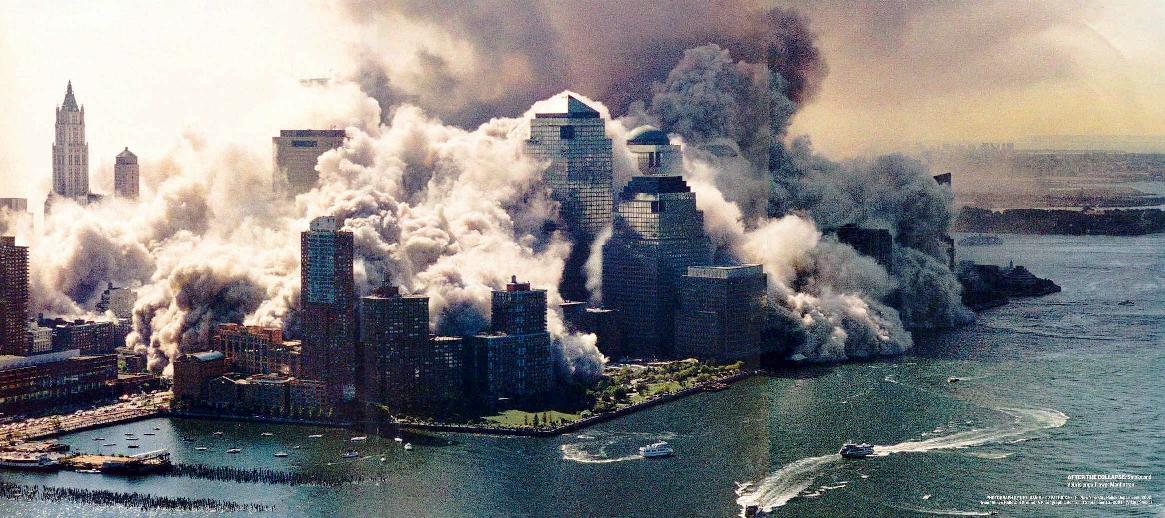
Det. David Fitzpatrick -
The New York City Police Department - 2002
[from "Above Hallowed Ground:
A Photographic Record of September 11, 2001" Viking Studio]
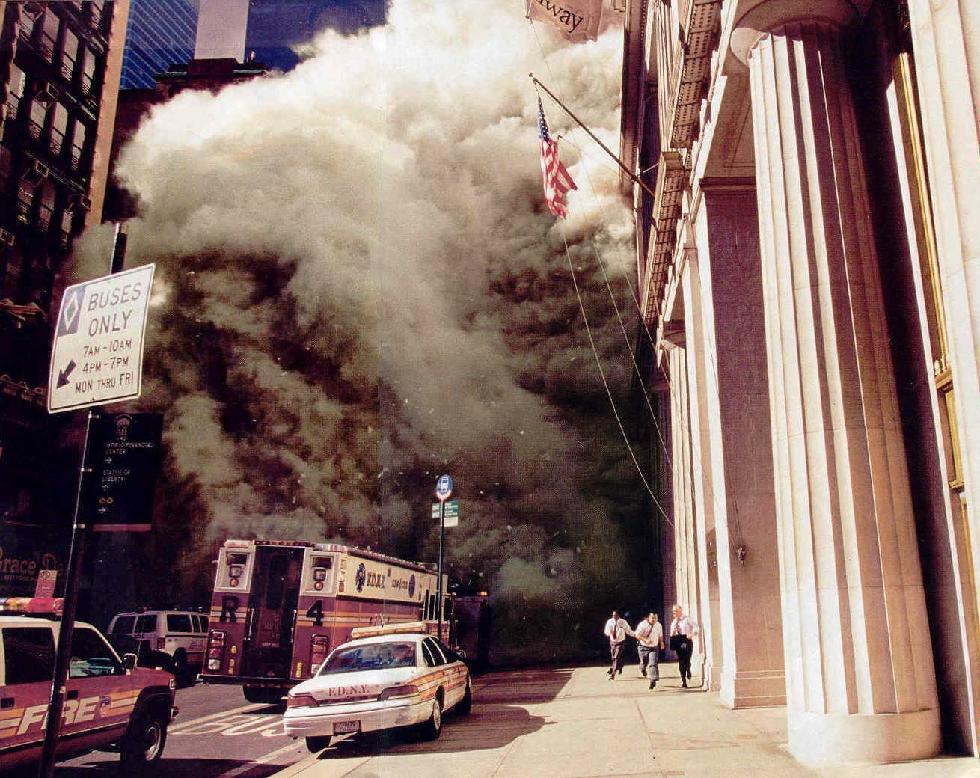
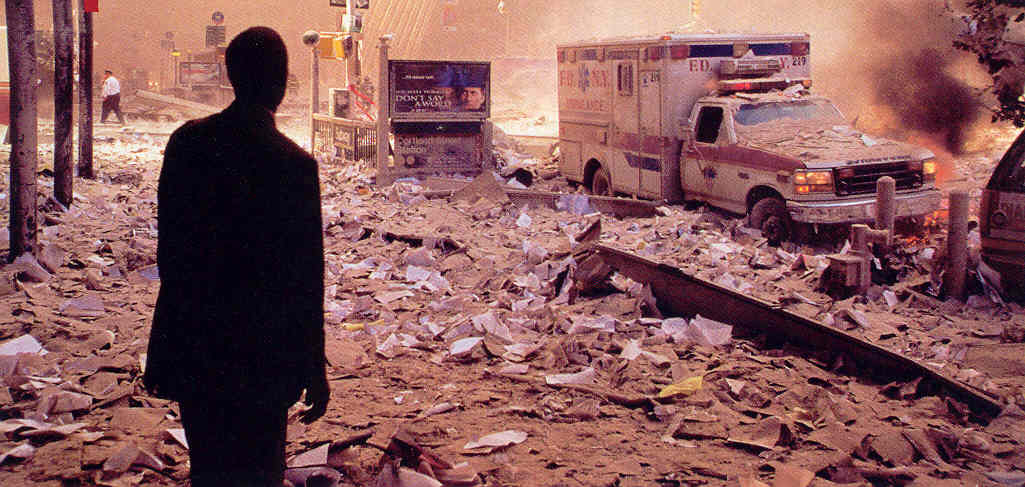
At 9:45 American Airlines
Flight 77 crashes into the Pentagon
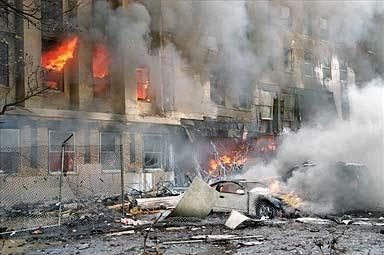 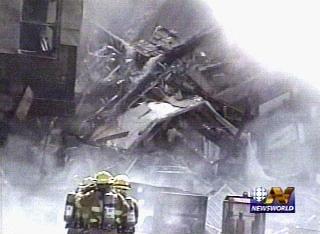 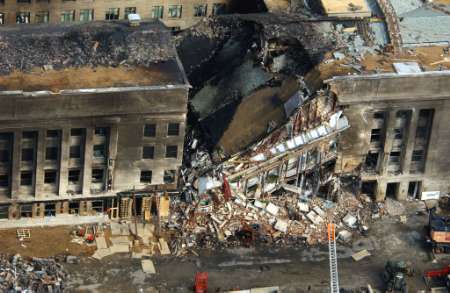
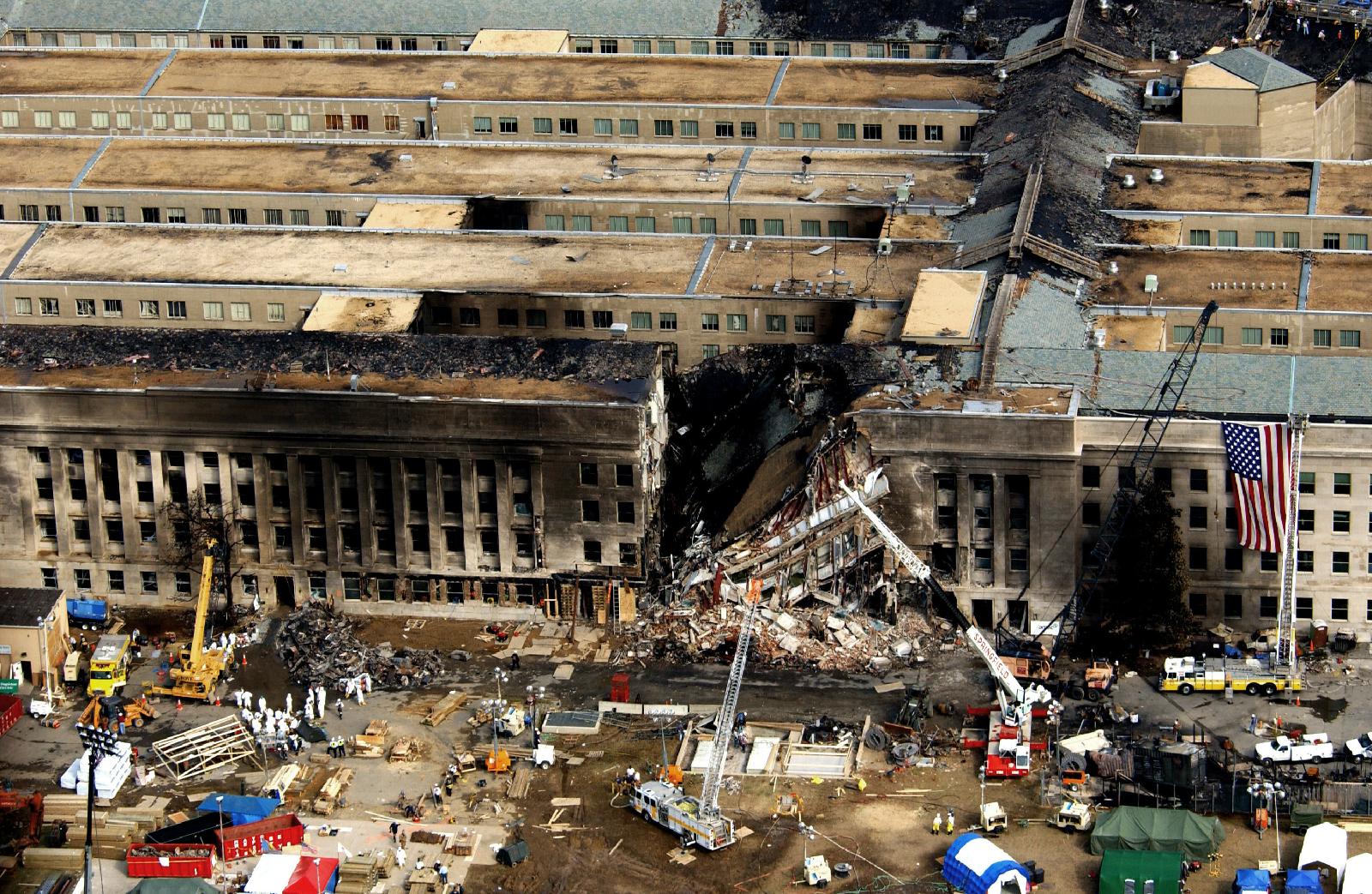
Aerial view of the Pentagon
Building located in Arlington, Virginia showing emergency crews responding
to the destruction
10:10 a.m. - United Flight
93 hijacked and turned toward Washington, D.C., crashes in a wooded area
in Stony Creek Township, Pennsylvania,
after passengers confront hijackers.
But mostly what remains
seems to be just a huge crater.
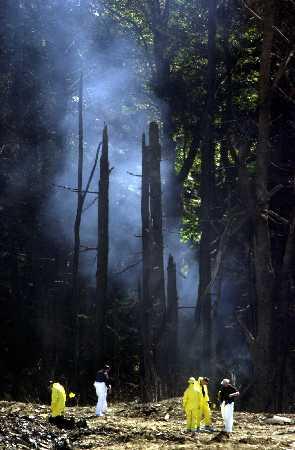 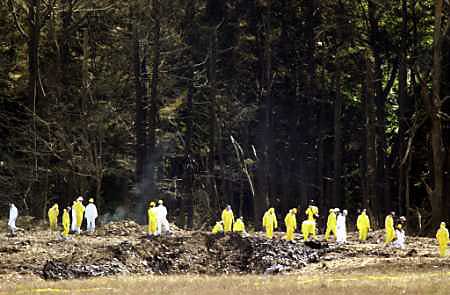
The aftermath of 9/11
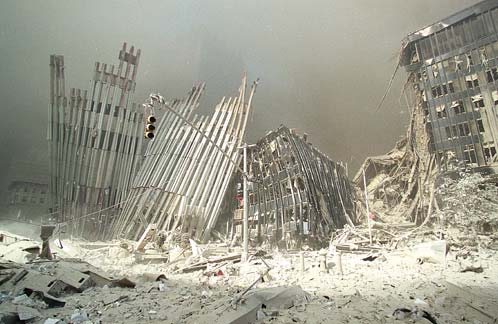 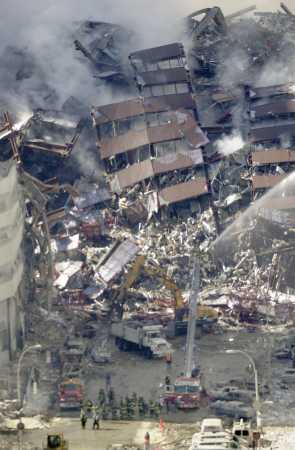 Aftermath of the collapse
at "Ground Zero"
Aftermath of the collapse
at "Ground Zero"

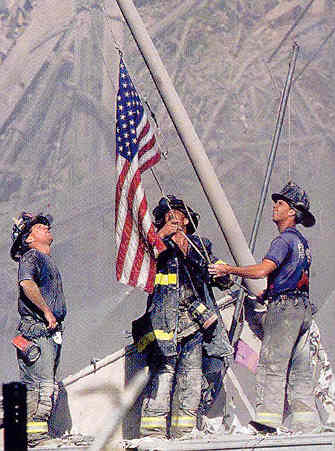
Three firemen raising the
American flag over "Ground Zero," September 11, 2001.
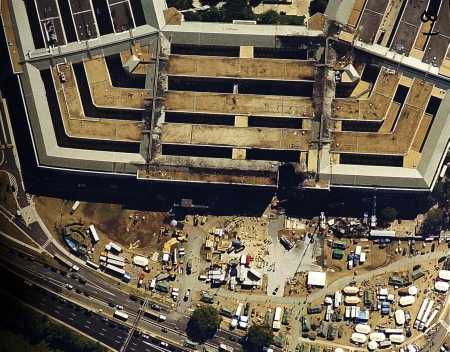 Cleaning up the
Pentagon
Cleaning up the
Pentagon
The hijackers: photos
released by the US Department of Justice
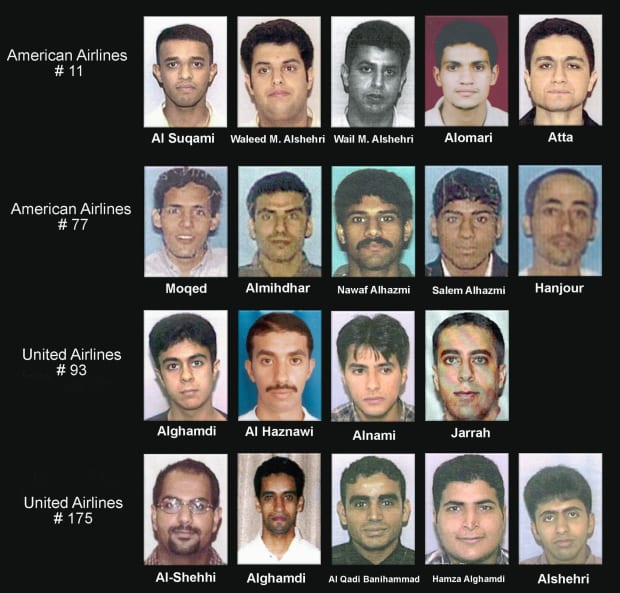
THE
WORLD PAYS TRIBUTE TO THOSE THAT DIED ON
9/11
Pictures from Ars Technica
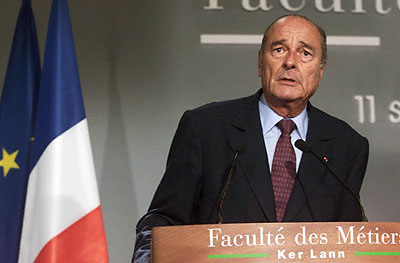
French President Jacques
Chirac announcing the tragedy
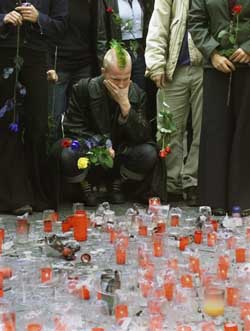 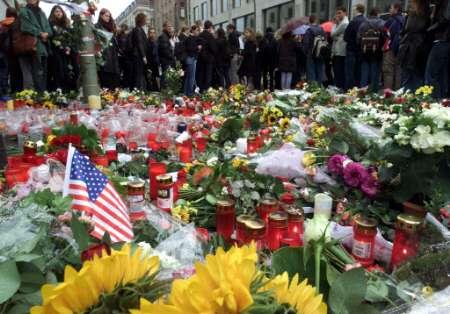 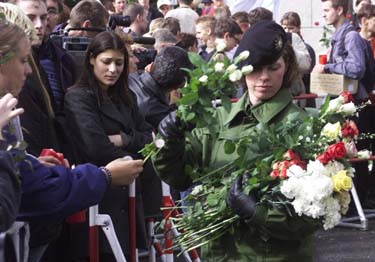 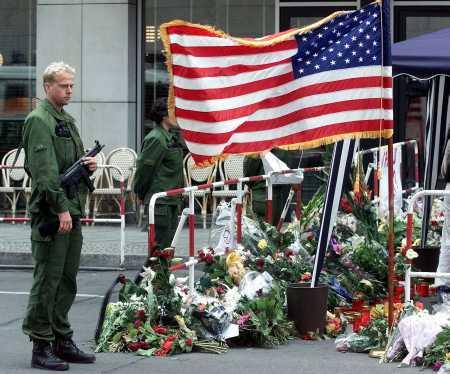
American Embassy, Berlin,
Germany
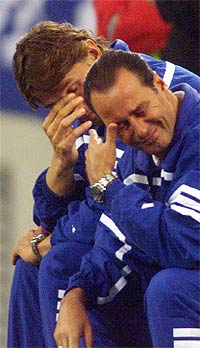 Players in a football
game in Germany, unwilling to compete after the attack.
The EUFA ordered
the game to be played, so for most of the game the players defiantly played
spiritlessly and uncompetitively.
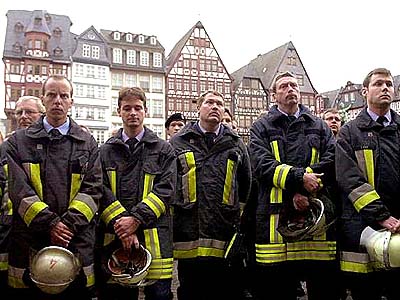 Frankfurt,
Germany Frankfurt,
Germany
 Munich, Germany Munich, Germany
For more (many more) pictures of the world's reaction to the 9/11 attack
Very
quickly a number of countries (most notably Britain, but also fellow
NATO members ... and others) indicated a willingness to join with
America in going after the al-Qaeda groups training in Afghanistan.
Bush thus informed the Taliban that if they did not surrender the
al-Qaeda operatives to America, America and its allies would be forced
to do the job themselves. But the Taliban refused to cooperate.
But instead of simply setting up a strike team ready to go quickly
after the al-Qaeda trainees, Bush decided to expand matters
considerably with his "Bush Doctrine" aimed more broadly at any
authority, any government, openly supporting such behavior as
al-Qaeda's ... any society allowing the tyranny of such Muslim
fanaticism to exist in its territory. Such a country was destined to
find itself in direct conflict with America.
How exactly Bush planned to enforce his Bush Doctrine remained
something of a mystery. As for Afghanistan, that was fairly clear. Bush
and America's allies were intending to invade Afghanistan and "liberate
" that country from Taliban-backed fanaticism. But what about nuclear
armed, and supposedly American-allied Pakistan? Pakistan made it very
clear that it too was not going to simply turn al-Qaeda operatives over
to America. Did Bush intend to invade Pakistan as well? And al-Qaeda
operatives were to be found all around the Middle East, such as the
Egyptian group that made the first attempt on the Twin Towers in 1993.
Was Bush going to take on the entire Arab World ... which seemed to be
in fair sympathy with al-Qaeda's goals of crippling Western society? In
any case, it quickly became clear that Bush had not carefully thought
through his Bush Doctrine. But now he was going to have to put some
meat on his boast to be this tough guy president ... with grand plans
to straighten out the world.
At first, the CIA prepared itself for immediate action against
al-Qaeda, by mobilizing operatives and by paying local Afghan tribal
lords to get them to help their operatives find and bring down al-Qaeda
leader Osama bin Laden. But then when in early October Bush amplified
the operation to the remaking of the whole of Afghanistan, the matter
was turned over to the Defense Department – which would then need some
time to get itself ready for a massive military operation against
Taliban Afghanistan.
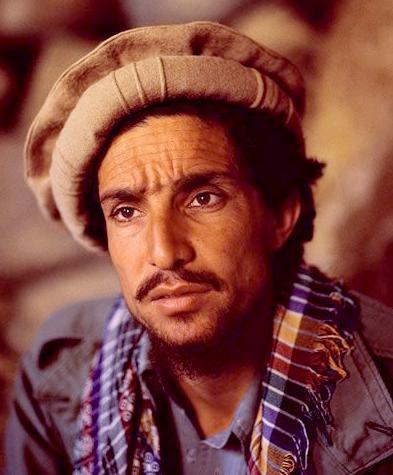 However,
working in favor of Bush's goal was the Northern Alliance. It had just
lost its leader (assassinated) Ahmad Massoud just two days prior to 9/11 –
probably in anticipation by al-Qaeda or the Taliban of how the Western
reaction to what they had planned for 9/11 might play out. But the
Northern Alliance did not fall apart and, with the help of American
(and NATO) firepower, was able to take control in the northern city of
Mazar-i-Sharif in early November and then use its airport to bring in
military supplies and even food for its troops and people. Then they
marched on Kabul, and quickly sent the Taliban into flight. However,
working in favor of Bush's goal was the Northern Alliance. It had just
lost its leader (assassinated) Ahmad Massoud just two days prior to 9/11 –
probably in anticipation by al-Qaeda or the Taliban of how the Western
reaction to what they had planned for 9/11 might play out. But the
Northern Alliance did not fall apart and, with the help of American
(and NATO) firepower, was able to take control in the northern city of
Mazar-i-Sharif in early November and then use its airport to bring in
military supplies and even food for its troops and people. Then they
marched on Kabul, and quickly sent the Taliban into flight.
Thus it all seemed to be over so quickly, so grandly. Celebrations were
held in Kabul – and around the Western world. Laura Bush, the
president's wife, even addressed the nation with a speech rejoicing how
such freedom was greatly received by the Afghans ... and especially by
its women, freed from Taliban oppression.
Of course the Taliban had not capitulated ... but instead had simply
retreated to a more defensible position in the Tora Bora Mountains ...
and were also able to hold their position at the southern city of
Kandahar in the heart of Pashtun territory ... which would then become
their new headquarters. Thus the Afghan war was hardly over.
In any case, American and NATO troops (and other smaller support
troops) were able to take position in the non-Pashtun lands of central
and northern Afghanistan ... and install in Kabul's Presidential Palace
a new Afghan president, Hamid Karzai. But exactly how much authority
Karzai would exercise outside of Kabul itself depended on two factors
... not necessarily connected: the ability of Western forces to secure
militarily various areas of the country, and the ability of Karzai to
enter into some kind of political relationship with the various tribal
chiefs located around the country ... at least in the North – outside
of Taliban-Pashtun territory.
Efforts would be made to roll back the Taliban from their position in
the south of the country. But these efforts would come to little ...
except the loss of life. And it became clear that the Western troops
would have to remain in place for the foreseeable future in order to
protect the part of Afghanistan that was "free." Thus a very expensive
settling in became part of the grand Afghan outcome.
|
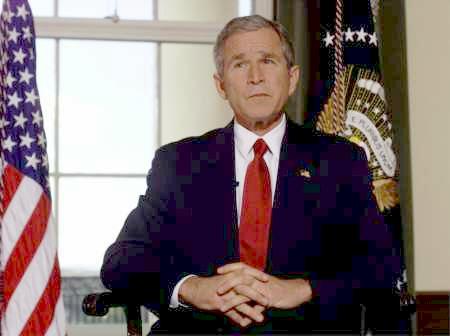
October 7, 2001 - President
Bush announces invasion of Afghanistan
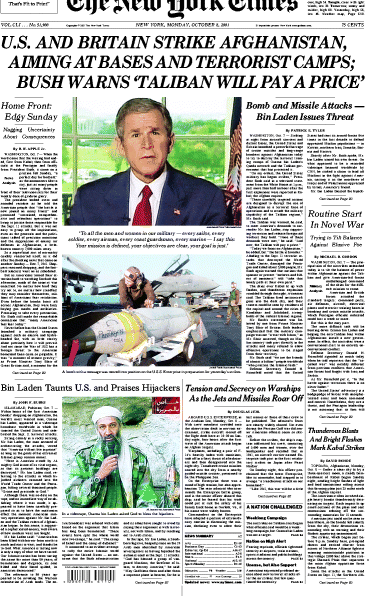
October 7, 2001 - The New York Times carries the full story
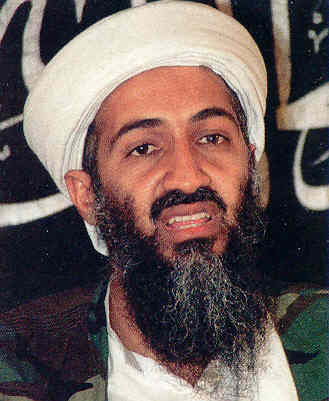
Osama Bin
Laden
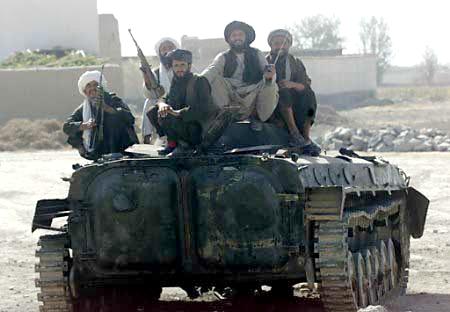
November 1 - The Taliban
in Kandahar
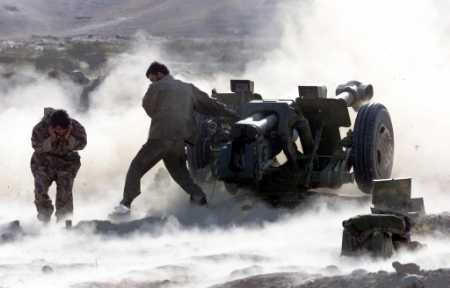
November 10 - The Northern
Alliance advances against the Taliban

A Portable laser designator
being used by a Special Operations captain in Afghanistan 2001directing Air Force and
Navy bombs
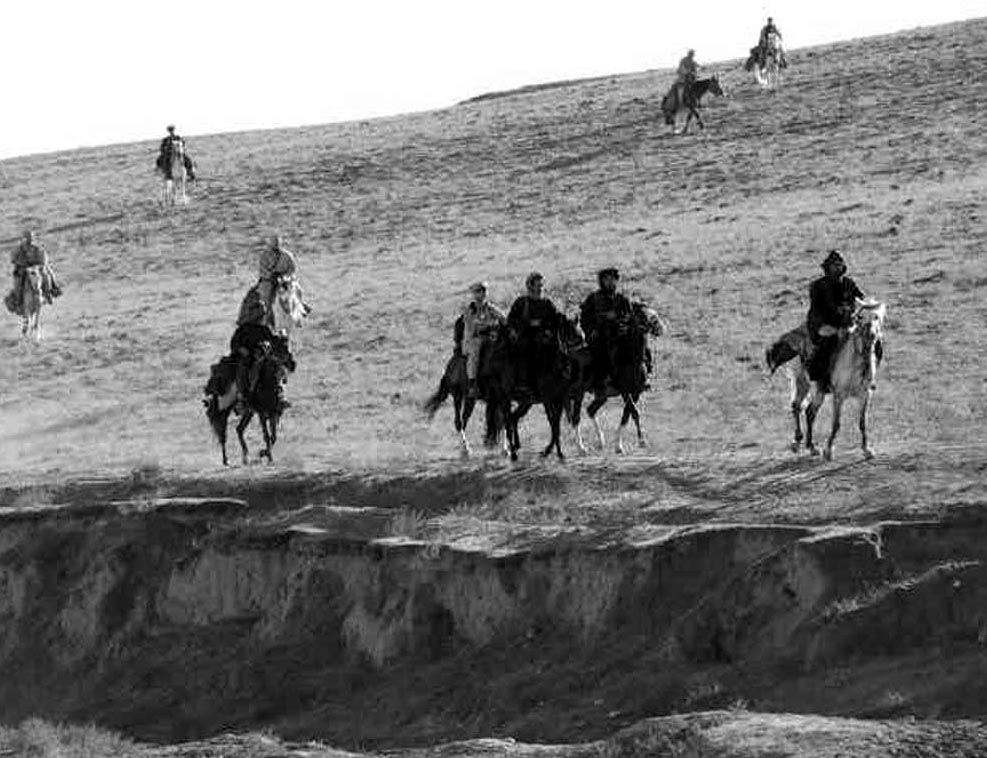
U.S. special forces troops
ride horseback as they work with members of the Northern Alliance in
Afghanistan
during Operation Enduring
Freedom on Nov. 12, 2001
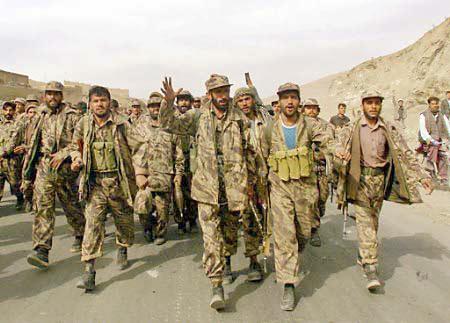
November 12 - The Northern
Alliance enters Kabul
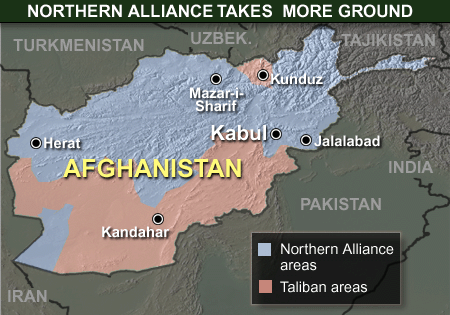
November 14 - The Northern
Alliance takes more ground
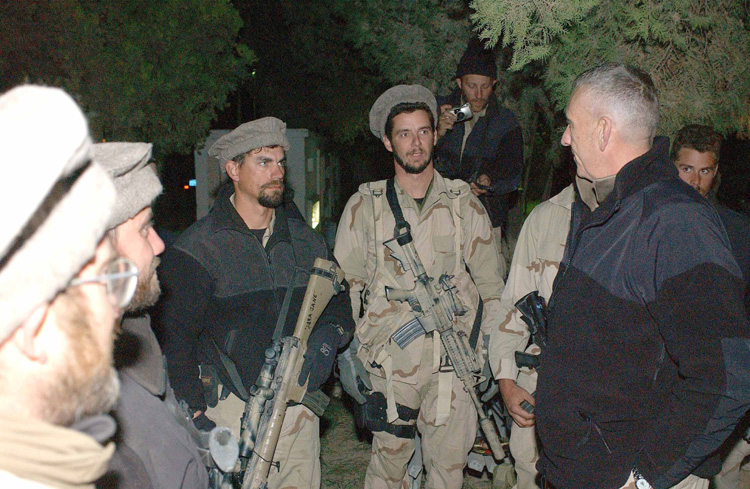
General Tommy Franks meeting
with members of Army Special Forces
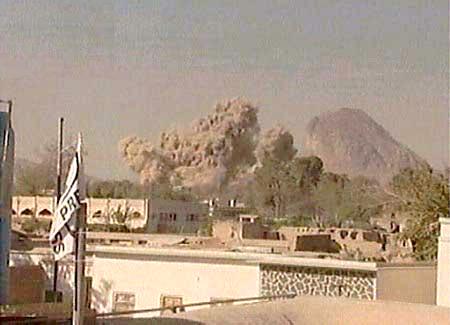
November 15 - The bombing
of Taliban positions at Kandahar
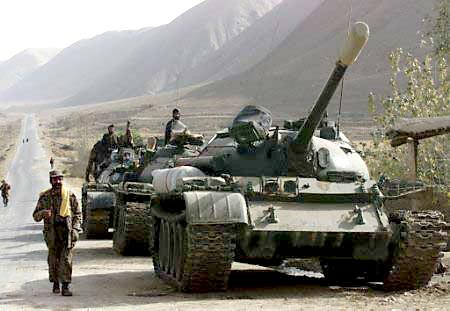
November 21 - The Northern
Alliance enters the Kunduz Province
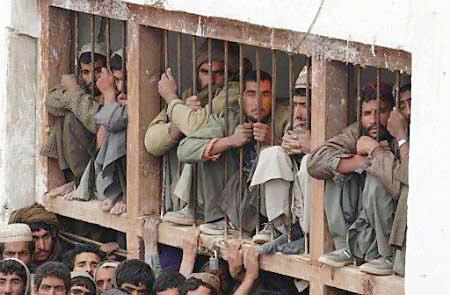
December 5 - Taliban prisoners
- Mazar
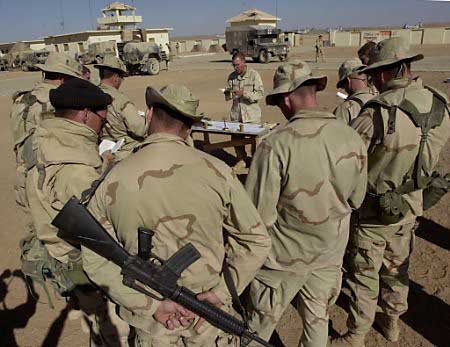
December 9 - Marine Camp
Rhino services

December 14 - To Kandahar
Airport

December 22 - Hamid Karzai
sworn in as Afghan Interim Prime Minister
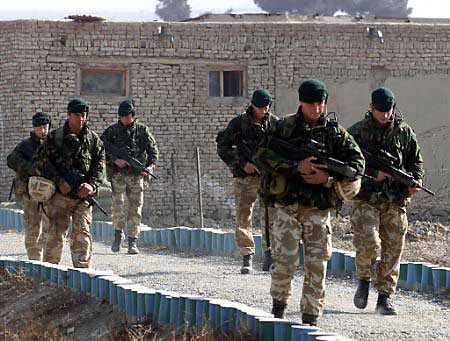
January , 2002 - British
Marines - Kabul
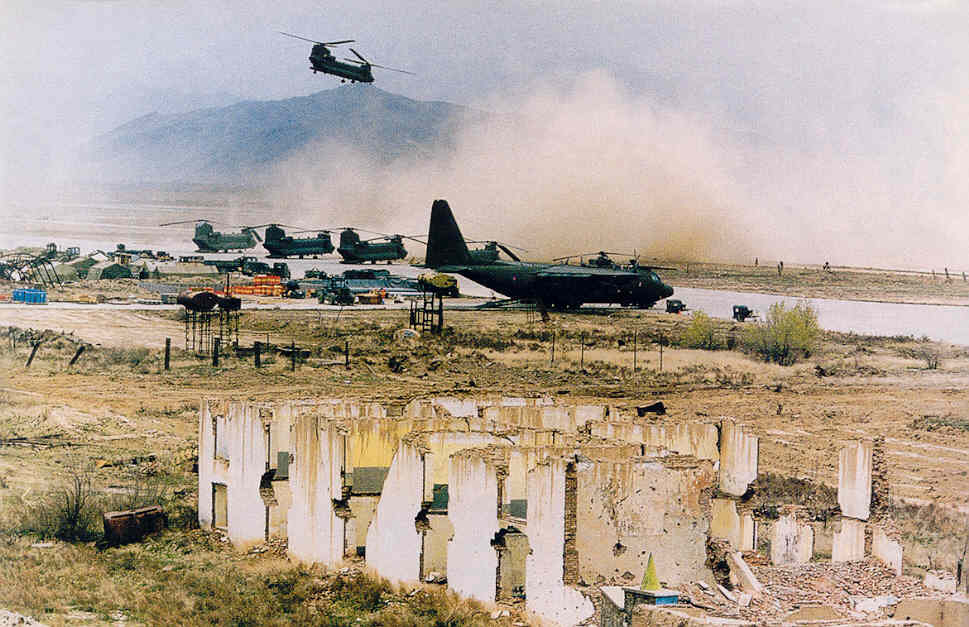
US Chinook helicopters at
Baghram Air Force Base outside Kabul in Afghanistan

March
2002
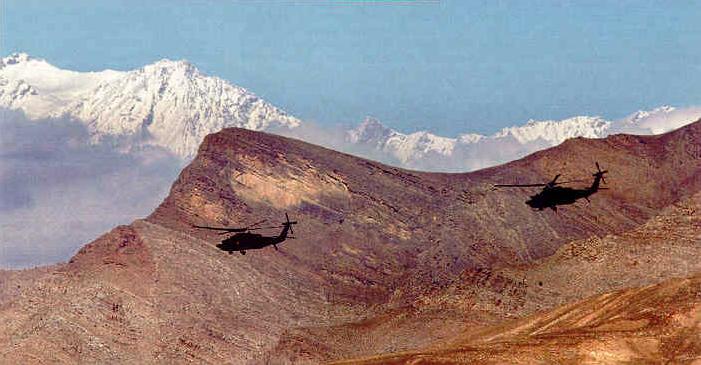
March
2002
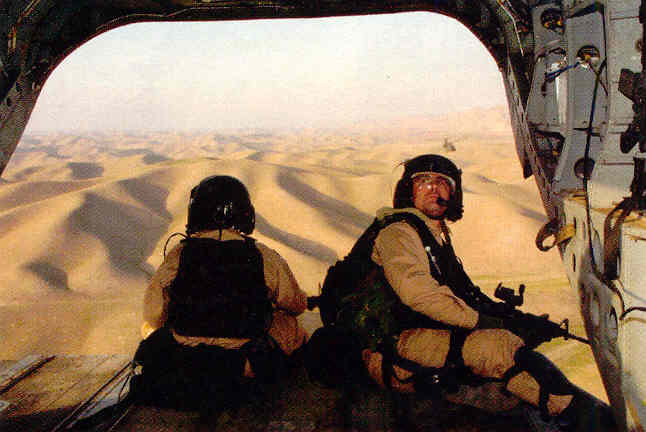
Special Forces scouring Afghanistan
from a Chinook helicopter during Operation Anaconda
- April
2002
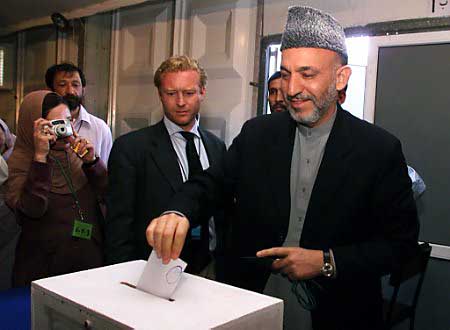
June 13, 2002 - Hamid Karzai wins
the elections for President of the Afghan Loya Jirga
(Parliament)
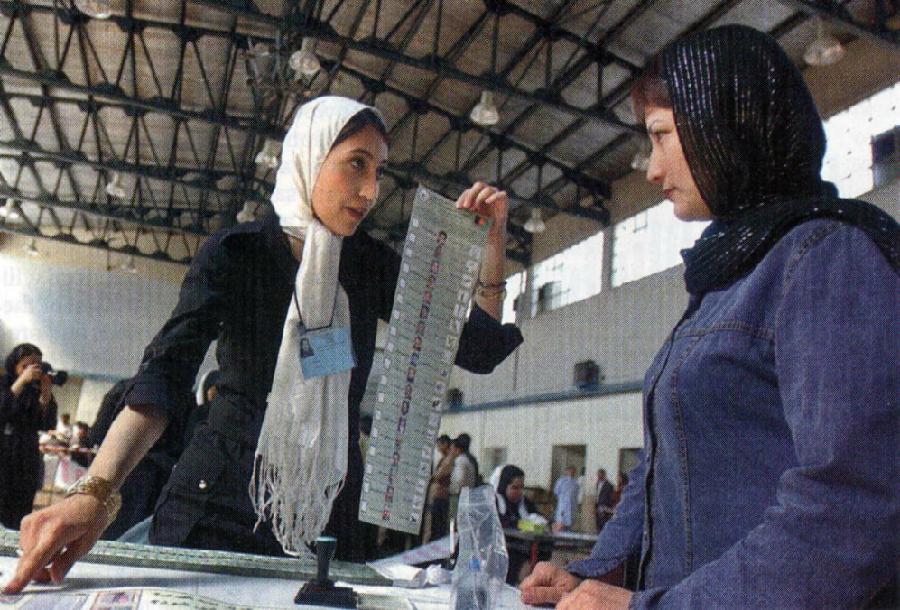
An Afghani voter being instructed
on how the voting works
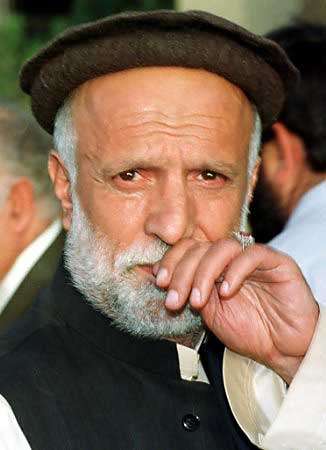 July 6, 2002 - Afghanistan
Vice President Haji Abdul Qadir and his driver are assassinated in a Kabul
Street during daring daytime attack
July 7 - His funeral in
Kabul 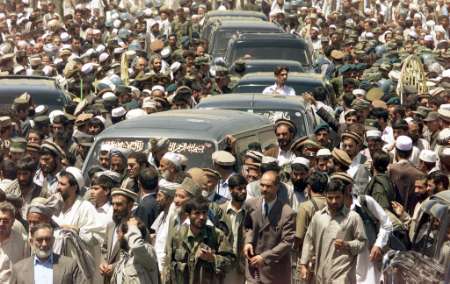
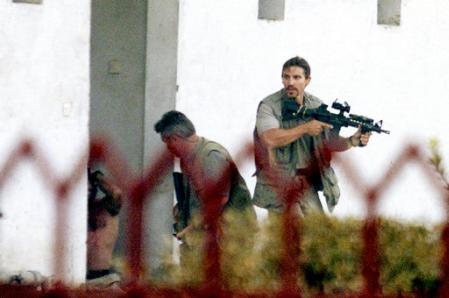
September 5, 2002 - US Special
Forces secure area after attempted assassination of Karzai
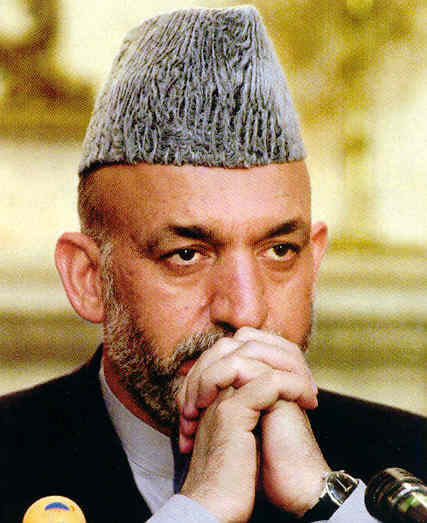
Hamid Karzai - Afghan
President

Afghan President Hamid Karzai
meets with tribal leaders from the Kunduz province
But tragically, despite the "democratic process" brought to Afghanistan,
the fighting continues
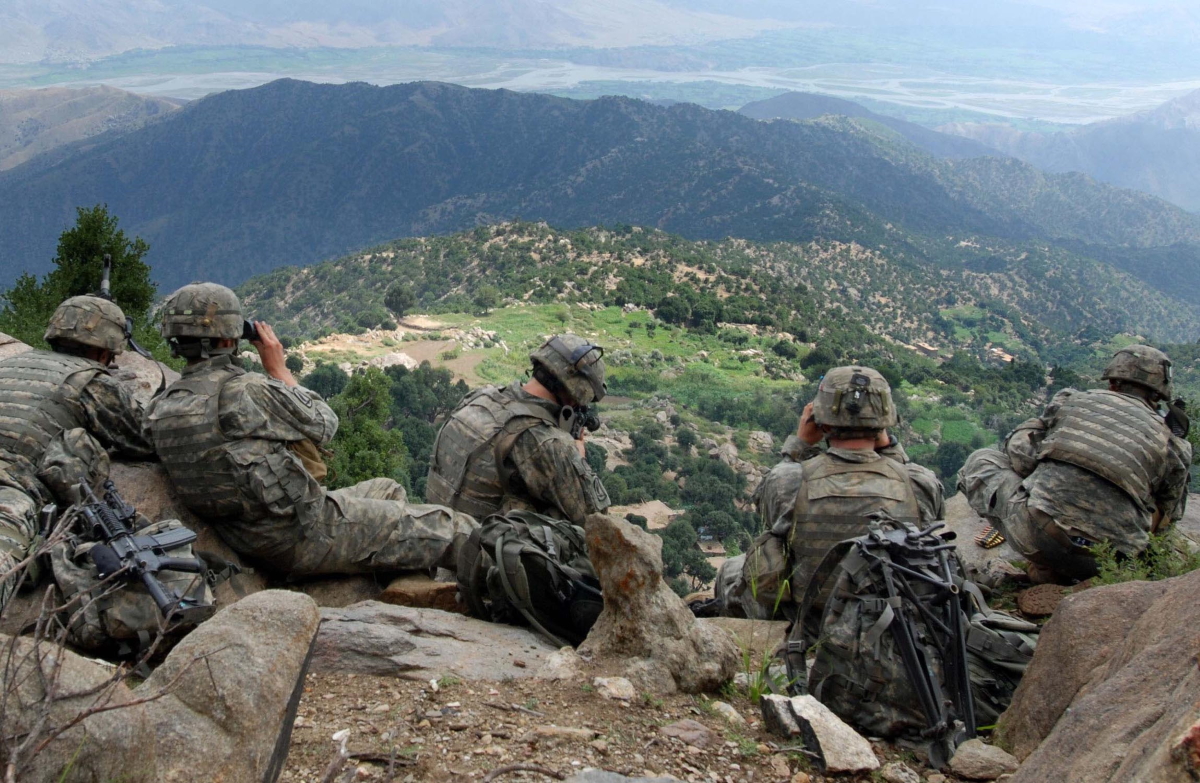
Scouts from 2nd Battalion,
503rd Infantry Regiment (Airborne), pull overwatch during Operation Destined Strike
while 2nd Platoon, Able Company searches a village below in the Chowkay Valley in Kunar
Province, Afghanistan
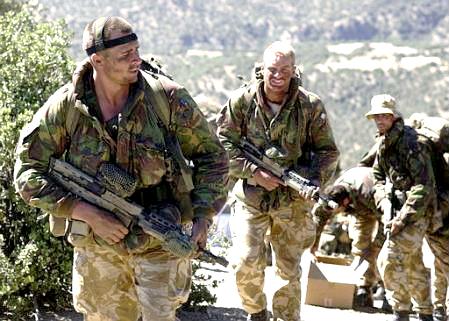
British Royal Marine Commandos
in Southeastern Afghanistan - May 2004
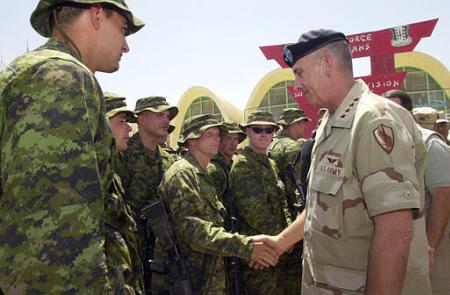
US General Tommy Franks greets
Canadian troops - Kandahar - May 2004
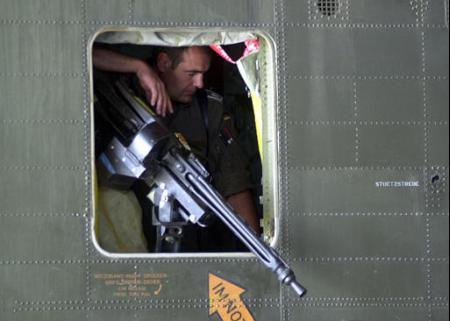
German door gunner - Kabul
airport - May 2004
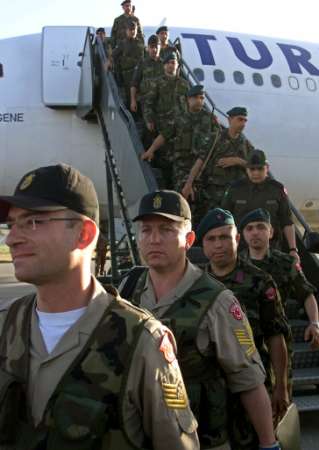
Turkish Troops arrive
at Kabul Airport to replace
British Soldiers in the
Afghan Capital - June 4, 2004
BUSH DECIDES TO TAKE ON SADDAM'S IRAQ |
For
reasons known only to Bush, Jr., he soon decided that the world would
be a much better place if Saddam Hussein would simply disappear. The
only problem was that he found he had no good excuse for undertaking
such a move. At first he tried to use his Bush Doctrine, claiming that
Saddam had to go because of his support of al-Qaeda. But he had no
actual evidence of such a connection ... and he found that convincing
the world otherwise was going nowhere. Then he went back to the old
weapons-of-mass-destruction (WMDs) accusation leveled against Saddam.
But coming up with evidence for this proved to be more confusing than
confirming. And as time went along, he found his NATO partners not
interested in supporting him ... except for the British Prime Minister
Tony Blair – who had long cultivated a very close relationship with
both Presidents Clinton and Bush, Jr. ... and who seemed ready to go
with Bush on this matter. Sadly in doing so it would eventually turn
out to be Blair's political downfall.
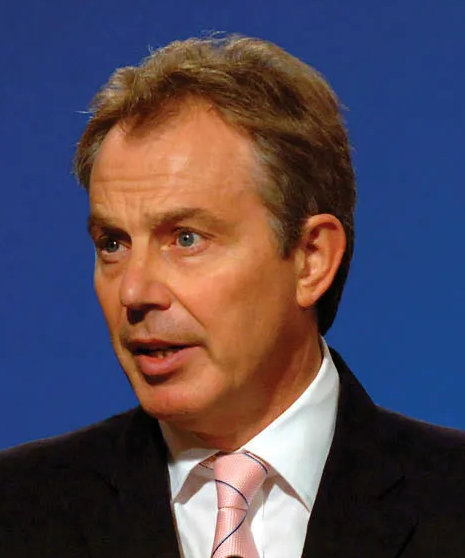
Tony Blair - British Prime Minister
Not even Bush's cabinet was in one accord on this move against Saddam.
The CIA chief, George Tenet, Secretary of State (and former military
man) Colin Powell, and National Security Advisor Condeleezza Rice were
very hesitant about going after Saddam. Where was the evidence that
would justify such an aggressive action as taking down the leader of a
foreign country? But Secretary of Defense Donald Rumsfeld was all for
such a military action. He was eager to show what his new "professional
military" was capable of accomplishing. And Bush's closest advisor, his
Vice President Dick Cheney, was willing to overlook his 1994 assurance
to the press that going after Saddam would be to fall into a quagmire
... because it was very clear that Bush had his heart set on the
matter. Thus Cheney chose to support the President rather than warn him
of what clearly were the huge problems that would surely come their way
in undertaking this action.
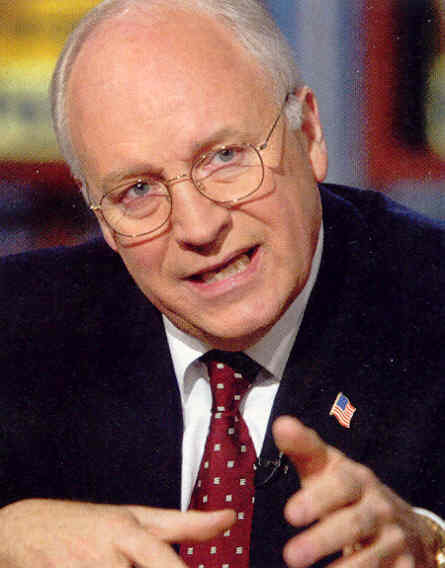
Vice President Dick
Cheney
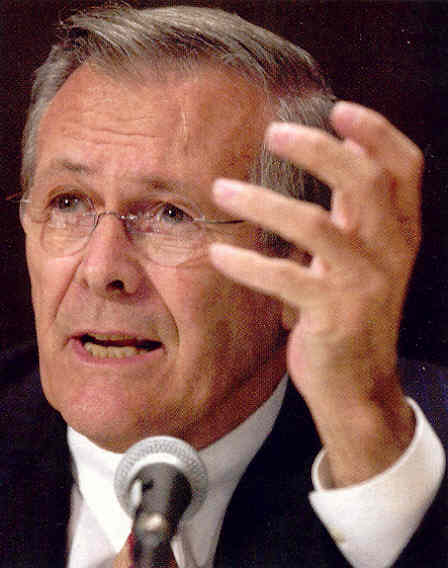
Secretary of Defense Donald
Rumsfeld
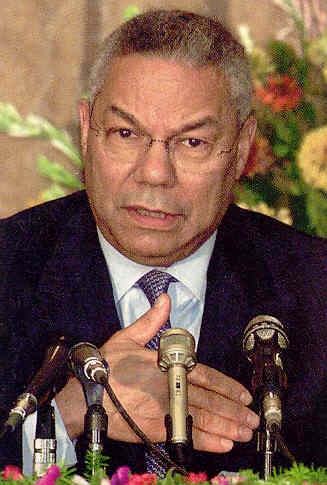 Secretary of State Colin
Powell 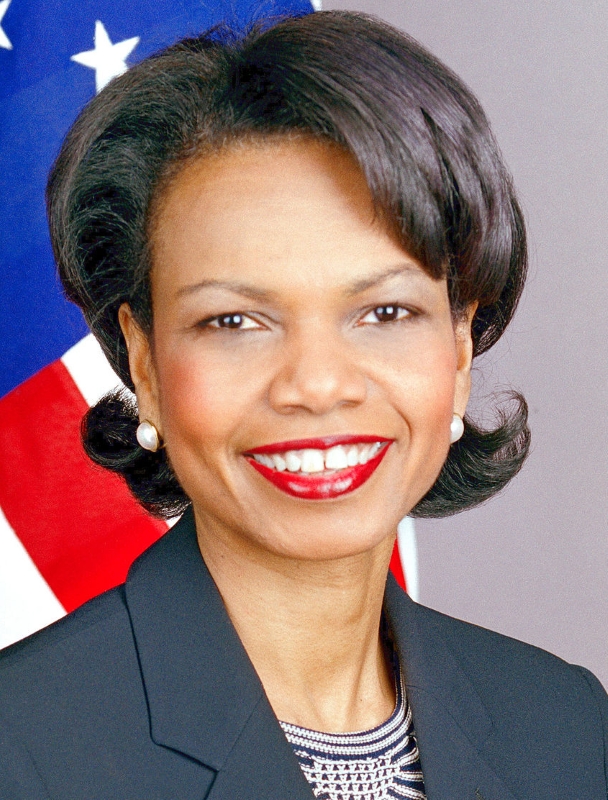
National Security Advisor, Condoleezza Rice
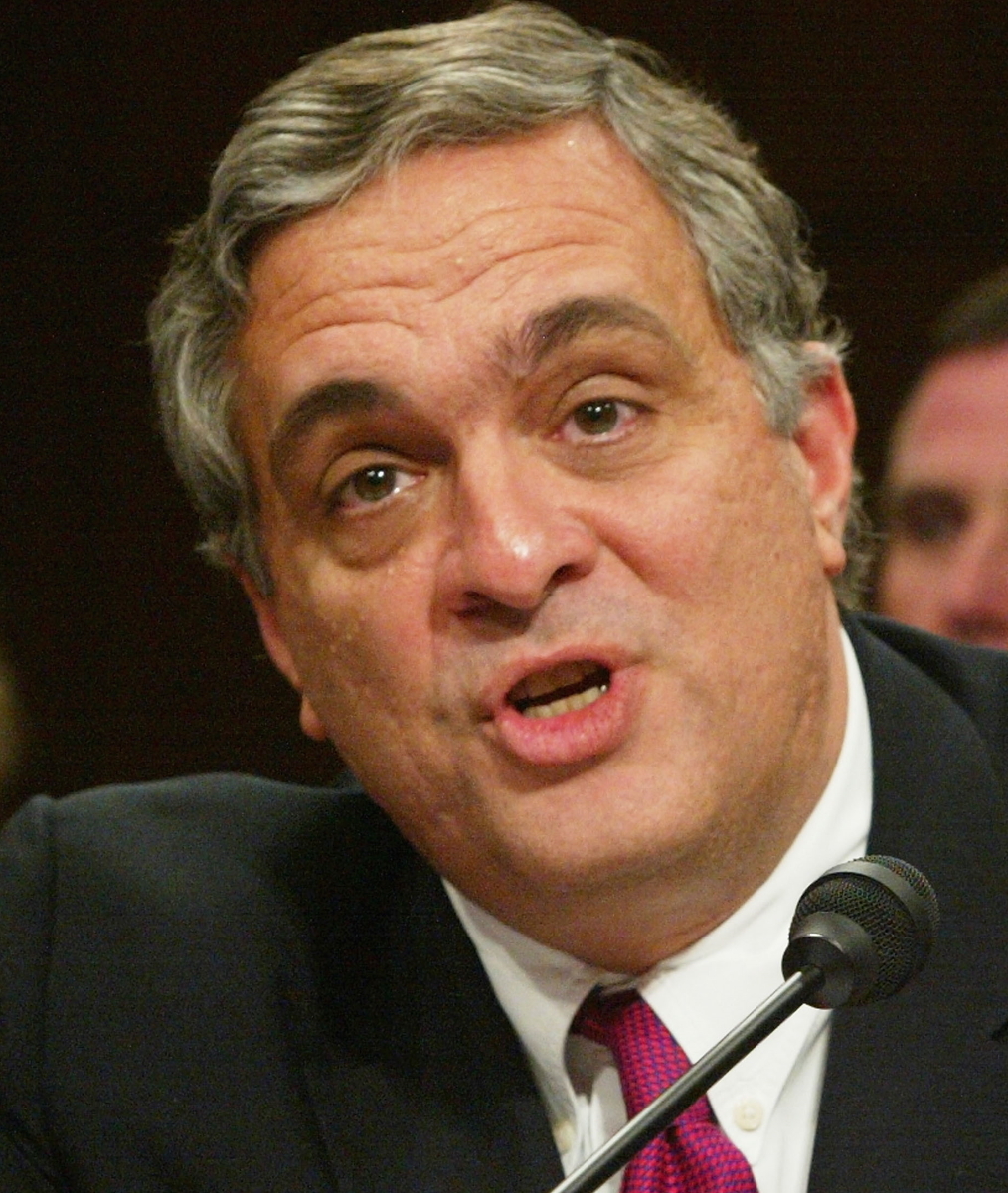 George Tenet – CIA Director
George Tenet – CIA Director
Backing
up his assurance that all would go well with the Iraqi program,
Rumsfeld assured Bush that he had a perfect candidate to assume power
in Iraq once Saddam was out of the way, Ahmed Chalabi. Chalabi hated
Saddam intensely (Saddam was Sunni, Chalabi was Shi'ite) and would do
everything he could to undo Saddam and his political legacy. Chalabi
had a Ph.D. in mathematics ... and was a full Westerner (or so his
loyalties were supposed to run) – having lived in the West since 1956.
But that very fact should have raised serious doubts about his strong
political foundations in a post-Saddam Iraq. Powell's State Department
was certain that Chalabi had absolutely no standing in Iraq. And the
CIA even considered the thought that he might actually be a Shi'ite
agent working for Iran. But Bush was not interested in what the CIA or
the State Department had to say on this matter.
In any case, in September of 2002, Bush went before the United Nations
to lay his case for Saddam's violation of Iraq's WMD prohibition ...
but came away only with the decision of the Security Council in
November to undertake renewed inspections in Iraq in the search for
such WMDs. This was not what Bush wanted. But for the moment he settled
with that agreement.
Then he went before Congress to get backing for his plans ... claiming
that Rumsfeld's Pentagon had come up with conclusive evidence that
Saddam was developing nuclear weapons. Supposedly Niger had sold Saddam
yellow cake uranium – vital to such weapons development (the whole
affair would later prove to have been untrue). At first the CIA would
not give a similar backing on the matter to Bush. But then Tenet simply
caved to pressure and offered additional "evidence" sought by Bush,
certifying that aluminum tubes had been discovered in Iraq, ones
certainly designed to be used as centrifuges in enriching uranium.
Finally, on the basis of this "evidence," Congress finally supported
Bush's program.1
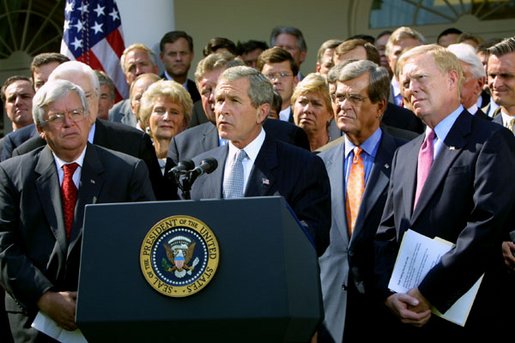
President George Bush introduces
the Joint Resolution to Authorize the Use of United States
Armed Forces Against Iraq, October 2, 2002. The resolution was passed
by both houses of Congress and signed into law two
weeks later.
Meanwhile, Bush's frustration with the U.N. WMDs search mounted ... as
the search came up with no evidence of any such development. Thus Bush
used his one last card to play in sending in February of 2003 the
highly respected Powell to the U.N., armed with photos, charts, etc.
"proving" conclusively that such WMDs in fact did exist in Iraq. But
even this seemed not to move the opinions of America's allies – except,
again, Blair's Britain. Then when an American resolution calling for
the execution of the "serious consequences" part of the earlier
agreement with Saddam looked as if it was going to run into the stiff
opposition of France, Germany, and Russia, Bush simply withdrew his
proposal. It was clear that he was going to get no backing from the
U.N. (or NATO as well).
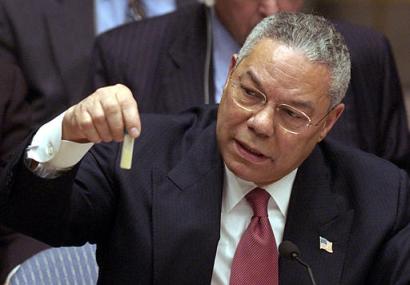
At the UN, Colin Powell holds
a model vial of anthrax, while arguing that Iraq
is likely to possess WMDs - 5 February 2003.
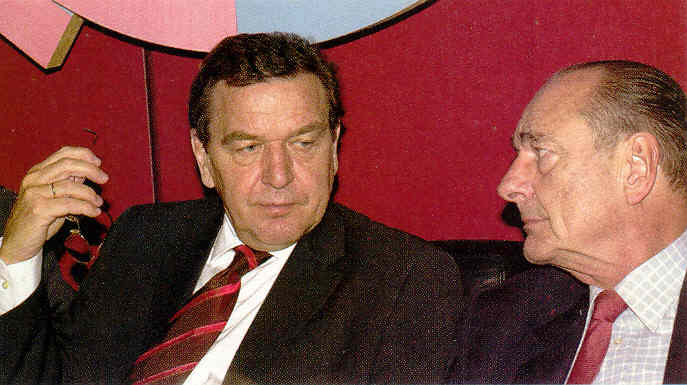
Some of America's key allies
decide that they are not with the US on the decision to invade Iraq (Germany's Chancellor Gerhard Schröder
and France's President Jacques Chirac)
1In
the House: 297 in support (215 Republicans and 81 Democrats) and 133
opposed (6 Republicans, 126 Democrats and 1 Independent). In the
Senate: 77 in support (48 Republicans and 29 Democrats) and 23 against
(only 1 Republican, 21 Democrats and 1 Independent). Notably, those in
support were Democratic Senators Biden, Clinton and Schumer ... who
would later come to regret their decision.
"Shock and Awe" (March 2003)
Bush was now ready to move on his own (with Blair's British
cooperation) – based on Rumsfeld's assurances that things would move as
swiftly in Iraq as they had in Afghanistan. They would quickly knock
out the Saddam government and then let Chalabi and his supporters
immediately form a new ruling team ... so that America could then back
out of Iraq before a stunned international community would even know
what just hit them!
The first part of Rumsfeld's assurances proved to be right – in that a massive aerial bombardment of Baghdad2
sent Saddam fleeing ... thus immediately collapsing his Ba'athist
government. But the second part of Rumsfeld's assurance was not even
close to having any real weight to it. Very quickly it was revealed
that Chalabi had no support group ready to take control in Iraq. In
fact, he was a quite unknown figure in that country.
Consequently, America now had a "quagmire" to deal with.
2The
American attack produced a very graphic picture of Baghdad in flames
... and thus the label "shock and awe" came to be assigned to the event.
|
| | | | |
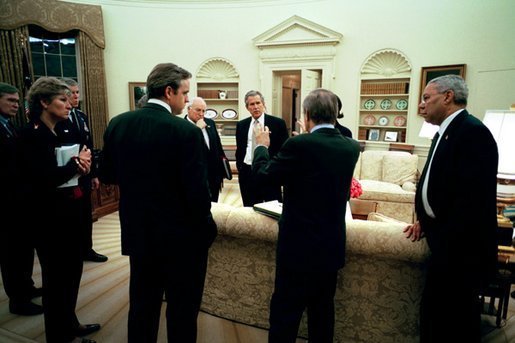
US President George W. Bush
meets with his top advisors on March 19, 2003
just before the invasion.
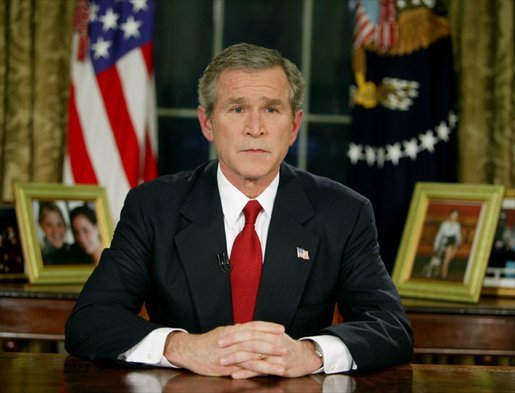
President George W. Bush
addresses the nation from the Oval Office at the White House
Wednesday evening, March
19, 2003, announcing the beginning of Operation Iraqi Freedom.
"My fellow citizens, at this hour, American
and coalition forces are in the early stages of military operations to disarm Iraq, to free its people and
to defend the world from grave danger ..."
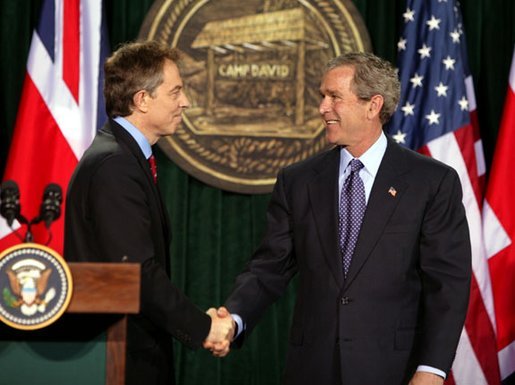
Prime Minister Tony Blair
shaking hands with President Bush, after they conclude a joint
news conference at the Camp David - 27 March 2003.
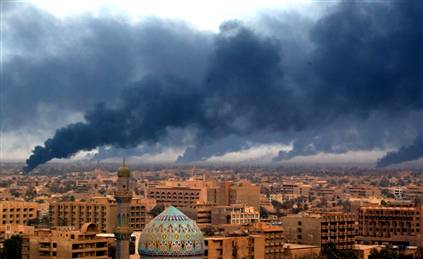
Saddam's Oil trenches burning
April 2, 2003 to cover and protect Baghdad
just prior to the US attack
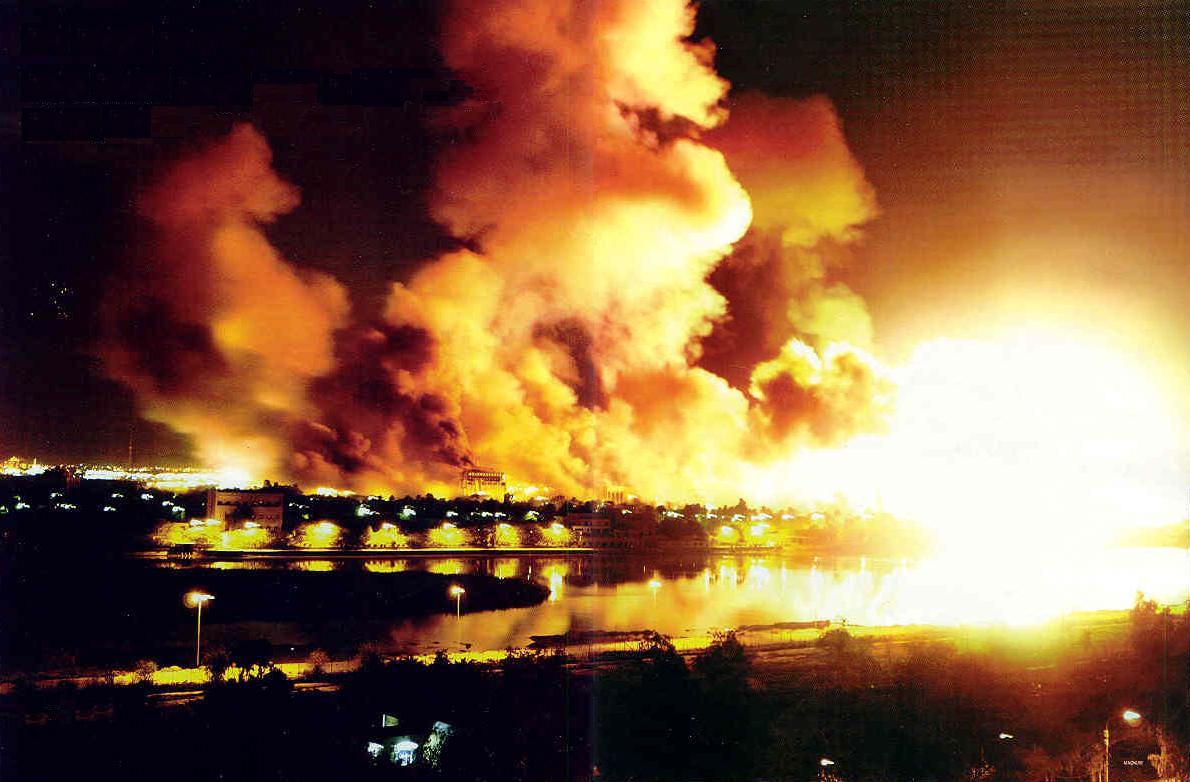
"Shock and Awe" over Baghdad
by US bombers
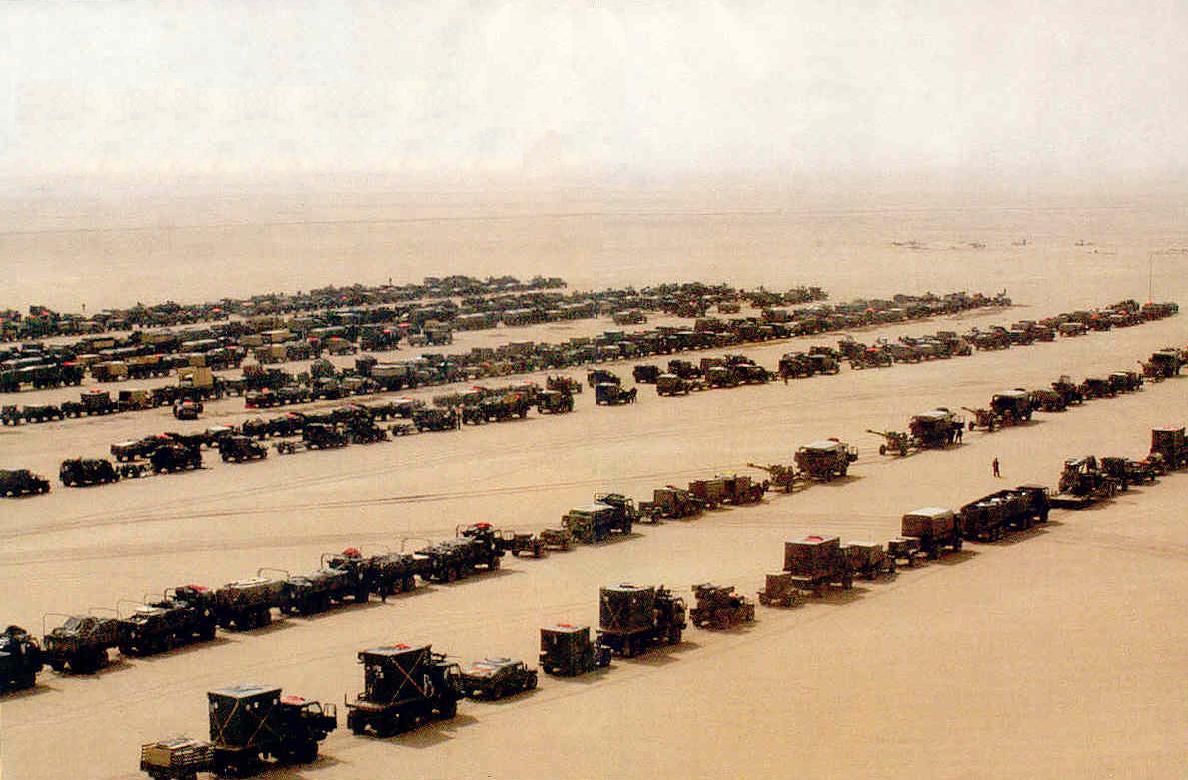
U.S. Forces preparing for
the ground invasion of Iraq
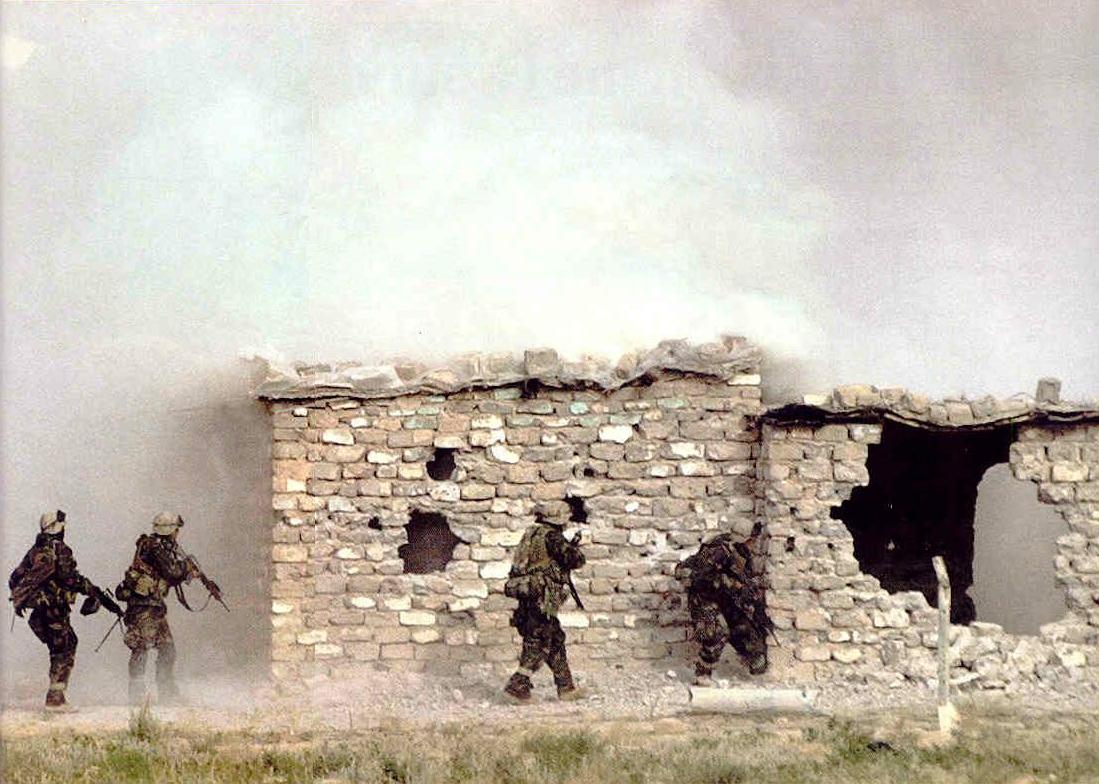
U.S. Forces going house to
house in search of Iraqi resistance

Refugees flee the fighting
in Basra, Iraq's second largest city.
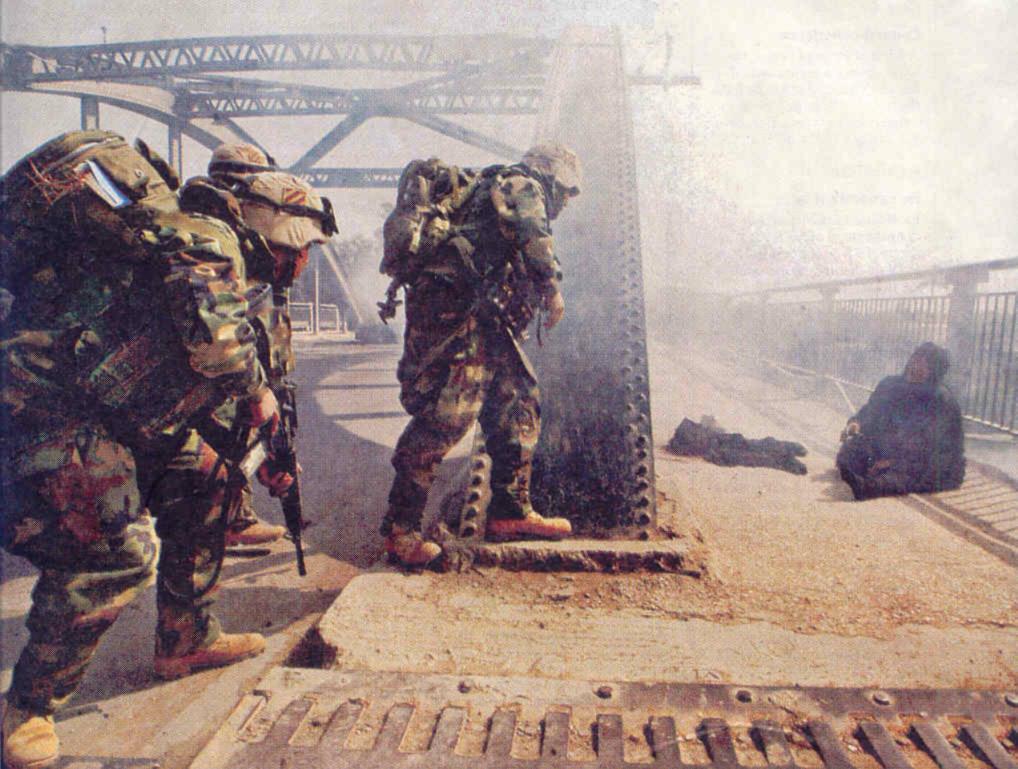
U.S. Army soldiers appraoch
a wounded Iraqi woman on a bridge over the Euphrates River
in Hindiyah.
The woman had been caught
in cross fire with Iraqi forces.
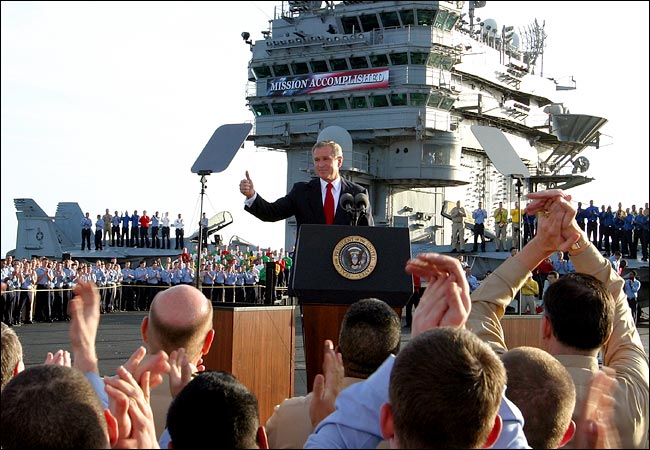 "Mission Accomplished"
"Mission Accomplished"
President Bush, after declaring
the end of major combat in Iraq, spoke on May 1, 2003, aboard the carrier Abraham
Lincoln off the California coast.
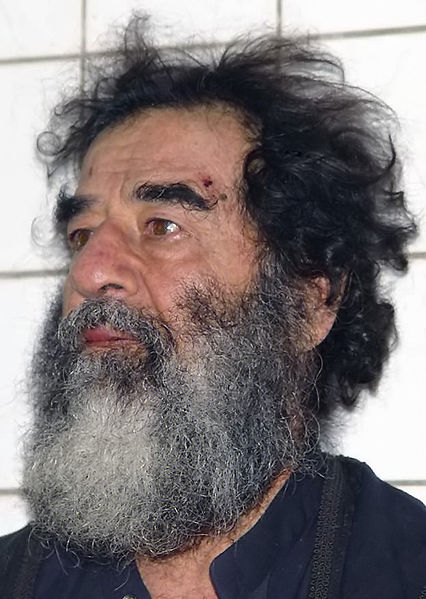
Saddam Hussein (14 December
2003) shortly after his capture
|
From very bad to catastrophic
With their dictator gone and Iraq now presumably a free country, the
Iraqis poured into the streets to celebrate their liberation. But
liberation also meant the disappearance of a regime of law and order,
which reflected itself in the rash of thefts ... such as ancient items
taken from the Iraqi Museum. But American military commanders were
quick to call on elements of the Iraqi army to help get things back in
order on the streets. Worse, long-standing Sunni and Shi'ite hatreds
now sparked religious reprisals, first by the Shi'ites against Sunnis,
the Shi'ites glad to be out from under Sunni control enforced by
Saddam's Ba'athist Party. Then the Sunnis responded in kind ... and
thus Iraq found itself in a state of civil war.
Then in early May Bush sent to Iraq a new U.S. Administrator, Jerry
Bremer – a Rumsfeld appointee ... who had the intention of bringing
Iraq under his own personal mastery. Despite the warnings of the
previous Administrator not to do this, Bremer issued Order No. 1 ....
calling for the "deBaathification" of Iraq. Since no professional
positions were open to Iraqis unless they became members of the
Ba'athist Party, Bremer's Order No 1 removed every teacher, doctor,
civil engineer, civil servant, etc. from their jobs ... leaving the
country without any kind of local leadership or even professional
service. Then a week later he disregarded military advice and issued
Order No. 2 ... calling on all Iraqi military to surrender their guns
to American authorities. This these men were most unwilling to do ...
with the result that, on his very own, Bremer turned a huge number of
experienced Iraqi soldiers into bitterly anti-American fighters.
Within a few days the first attacks on the occupying American soldiers
began. And thus, General Franks and all the top military command – in
complete disgust over the way Bremer was handling matters in Iraq –
chose to "retire" ... leaving command in the hands of an inexperienced
one-star American general.
Also, the Shi'ites found themselves under a young leader, Muqtada
al-Sadr, who – instead of being grateful for the way the Americans had
freed their community from Sunni dominance – chose to turn his "Mahdi
Army" on the occupying troops (British as well as Americans) in order
to demonstrate his own personal coming-to-glory as the Shi'ite
community's new leader. And in this he was getting considerable support
from the bitterly anti-American Shi'ite Iran next door.
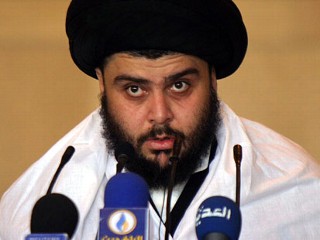
Shi'ite cleric Muqtada
al-Sadr
And the Kurds in the north saw this as an opportunity to pull out of
Iraq and set up their own independent Kurdish nation... a move destined
to plunge the Kurdish region into its own war, as Kurdish leaders
fought among themselves to take control. But it also infuriated
America's ally Turkey – where a huge Kurdish section of Turkey now
looked to the possibility of breaking away from Turkey in order to join
the Kurdish development.
What a catastrophe this all turned out to be. And tragically it was
entirely predictable ... for Iraq was always destined to be a
"quagmire, as Cheney himself knew beforehand. America now had a very
expensive war on multiple fronts in the region to contend with ... with
nothing really to gain from it all.3
A small bit of good news was that finally in June of 2004 Bremer was
able to announce the formation of a provisional Iraqi government and an
interim constitution. And Rumsfeld also announced that his troops would
now pursue a "small footprint" strategy of serving mostly as trainers
of Iraqi troops ... who would then take over as soon as possible
America's policing role in the country. This was supposed to be part of
his original idea that America would quickly depart once Saddam was
overthrown (he was actually found and arrested the previous December).
But this would not turn out to be the case, despite Rumsfeld's efforts
to bring things to a satisfactory resolution. And he would find it
necessary to depart from this strategy in order to hit hard local
opposition – as in Sunni Fallujah or constantly against al-Sadr's
Shi'ite Mahdi Army – and then return to base.
But the "good news" was enough to get Bush reelected to a second term as president.
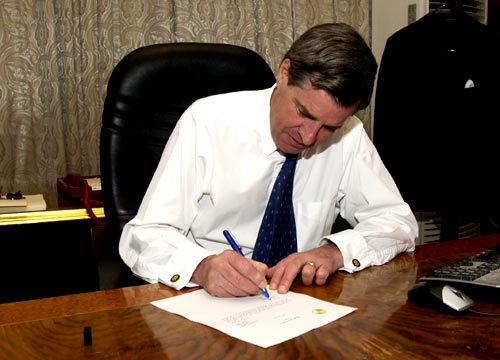
Bremer signing over limited
sovereignty to the appointed Iraqi interim government – June 28, 2004
3In
December of 2004, an incredibly ill-informed President Bush presented
Bremer America's highest civilian honor, the Medal of Freedom, stating:
"For fourteen months Jerry Bremer worked day and night in difficult and
dangerous conditions to stabilize the country, to help its people
rebuild and to establish a political process that would lead to justice
and liberty." However, at this point Iraq was hardly "stabilized" nor
experiencing justice and liberty – due mostly to Bremer's massive
political ineptitude. Bremer, however, blamed the very obvious Iraqi
catastrophe on the inadequate American military support he was expected
to work with. Working with the Iraqis themselves was way beyond
Bremer's understanding or abilities.
Ahmed Chalabi – who originally
had the ear of the US Department of Defense and supplied the (false)
info on the build-up of weapons of mass destruction (WMD) in Iraq (and who may have been working
for the Iranians)
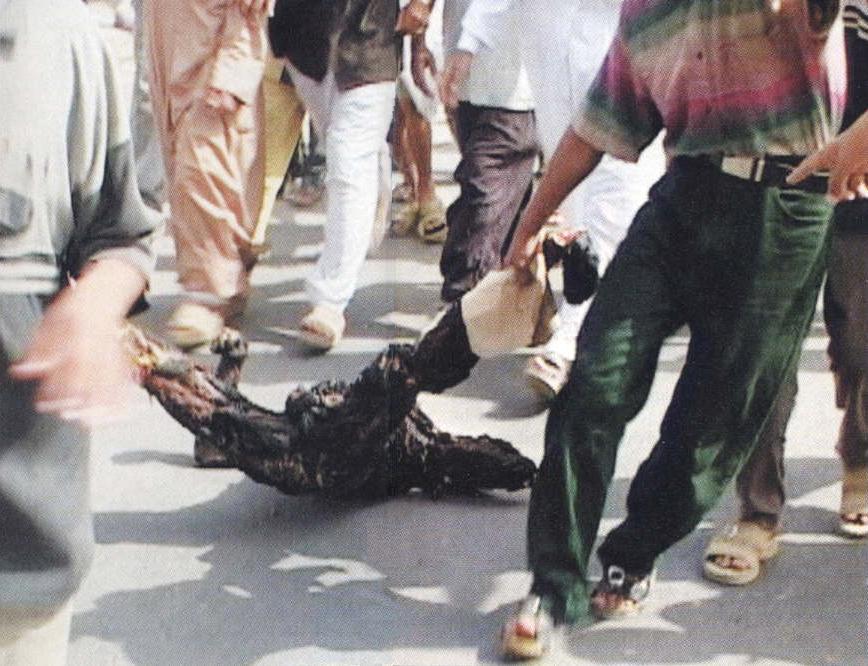 Iraqis in Fallujah dragging
through the streets the charred body of a US security contractor
Iraqis in Fallujah dragging
through the streets the charred body of a US security contractor
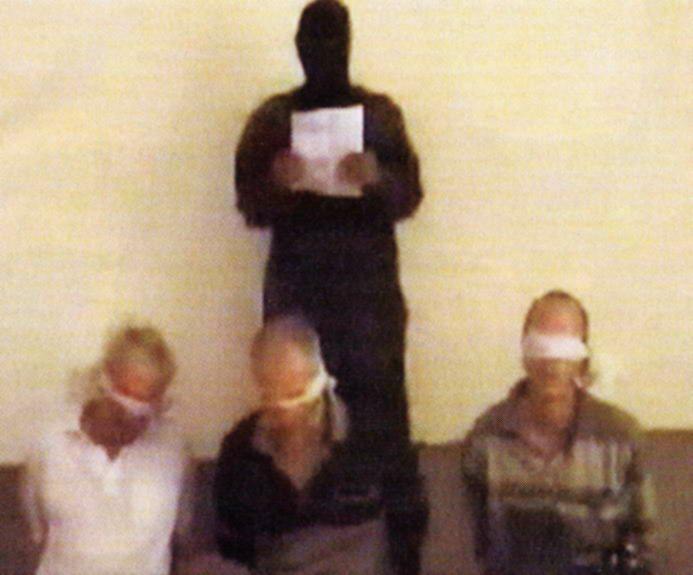 US and British soldiers being
held captive by al Zarqawi (the US troops were beheaded
in front of the camera)
US and British soldiers being
held captive by al Zarqawi (the US troops were beheaded
in front of the camera)

A picture of an Iraqi prisoner
at Abu Ghraib prison
who was told that he would
be electrocuted if he stepped off the box (not true -- but convincing
torture to a hooded prisoner nonetheless)
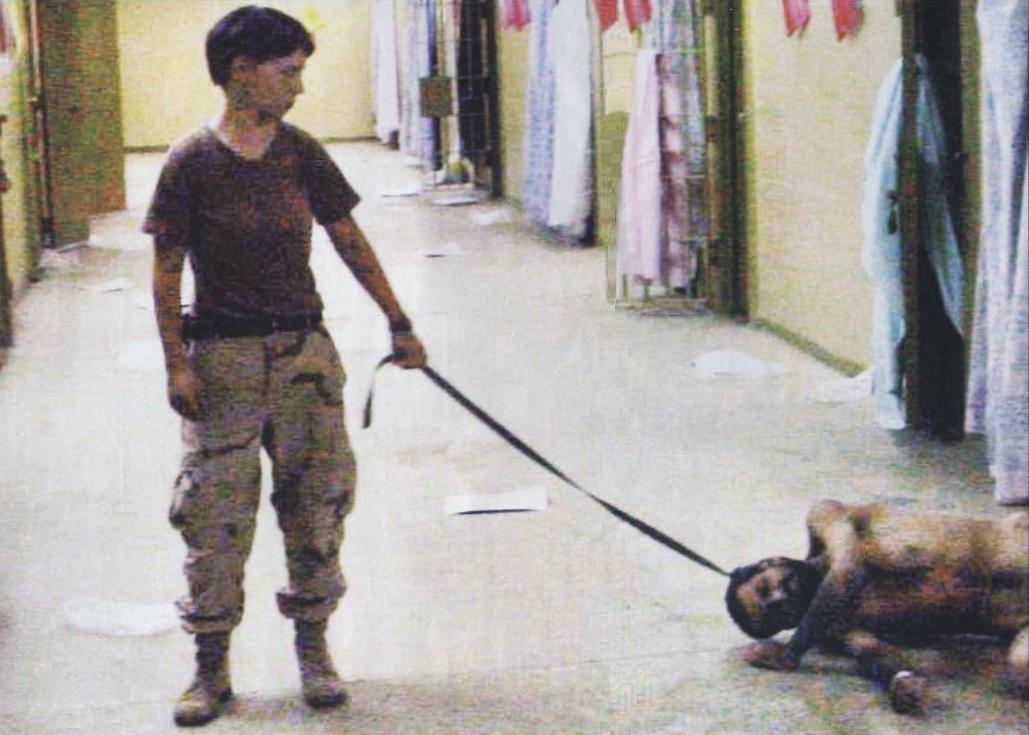
Private Lynndie England with
an Iraqi prisoner on a leash at Abu Ghraib prison in Baghdad
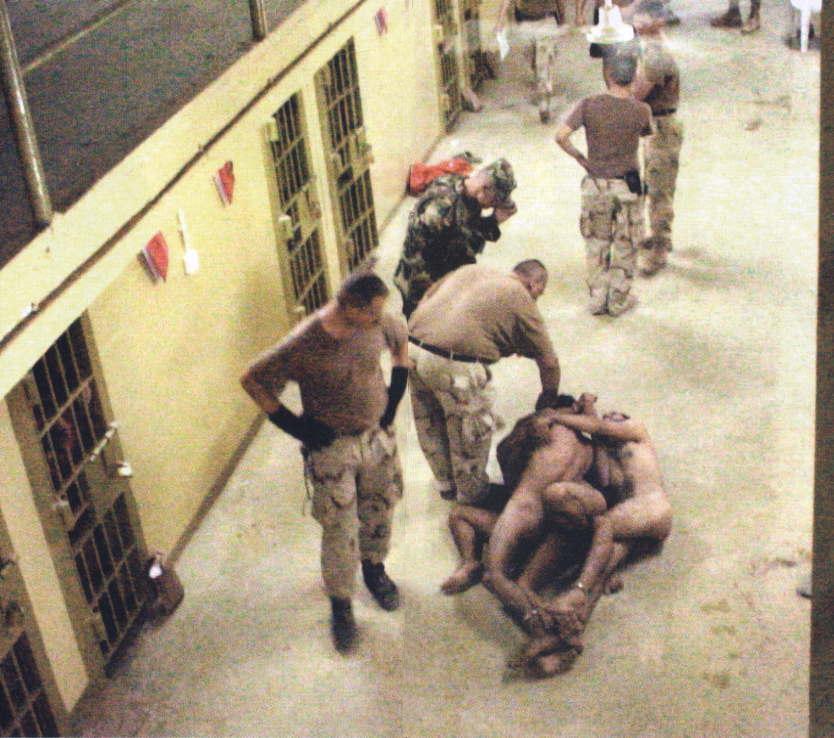
Naked Iraqis naked and bound
together under US troop supervision
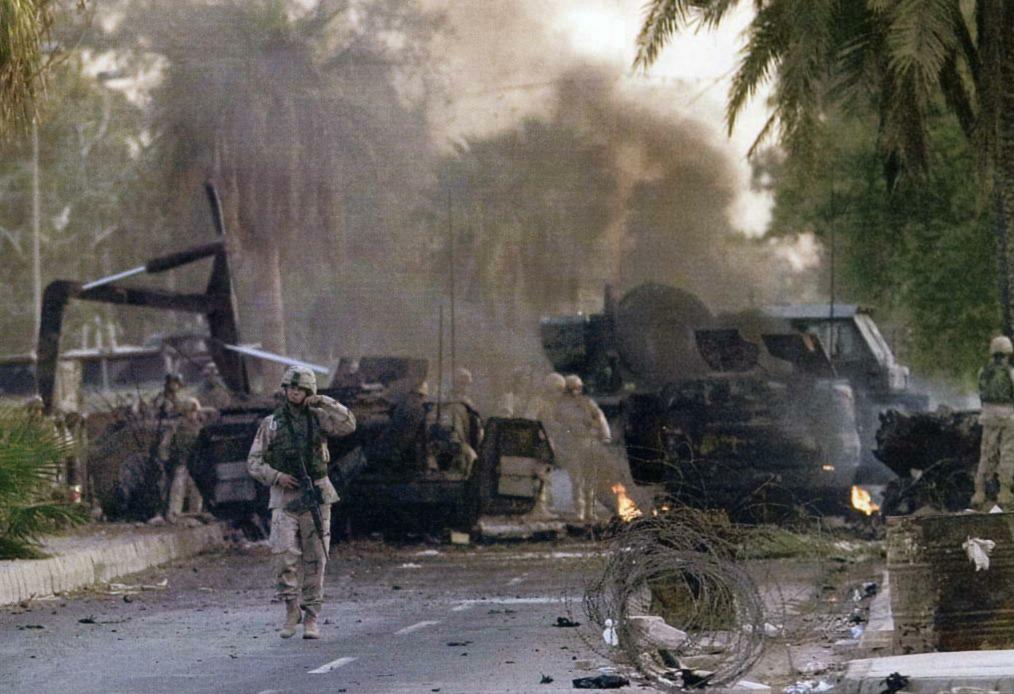
Another car bombing in
Baghdad
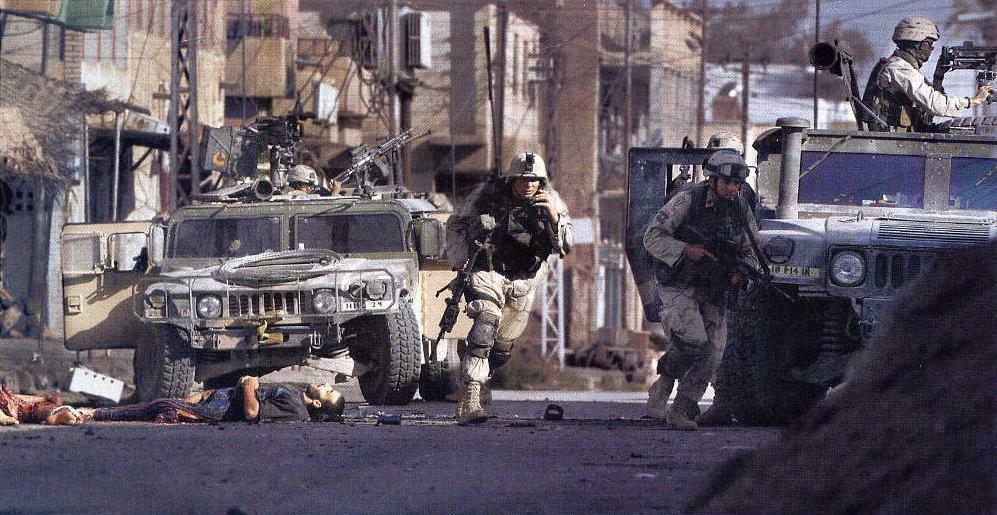
US troops in Samarra sweep
past dead insurgents
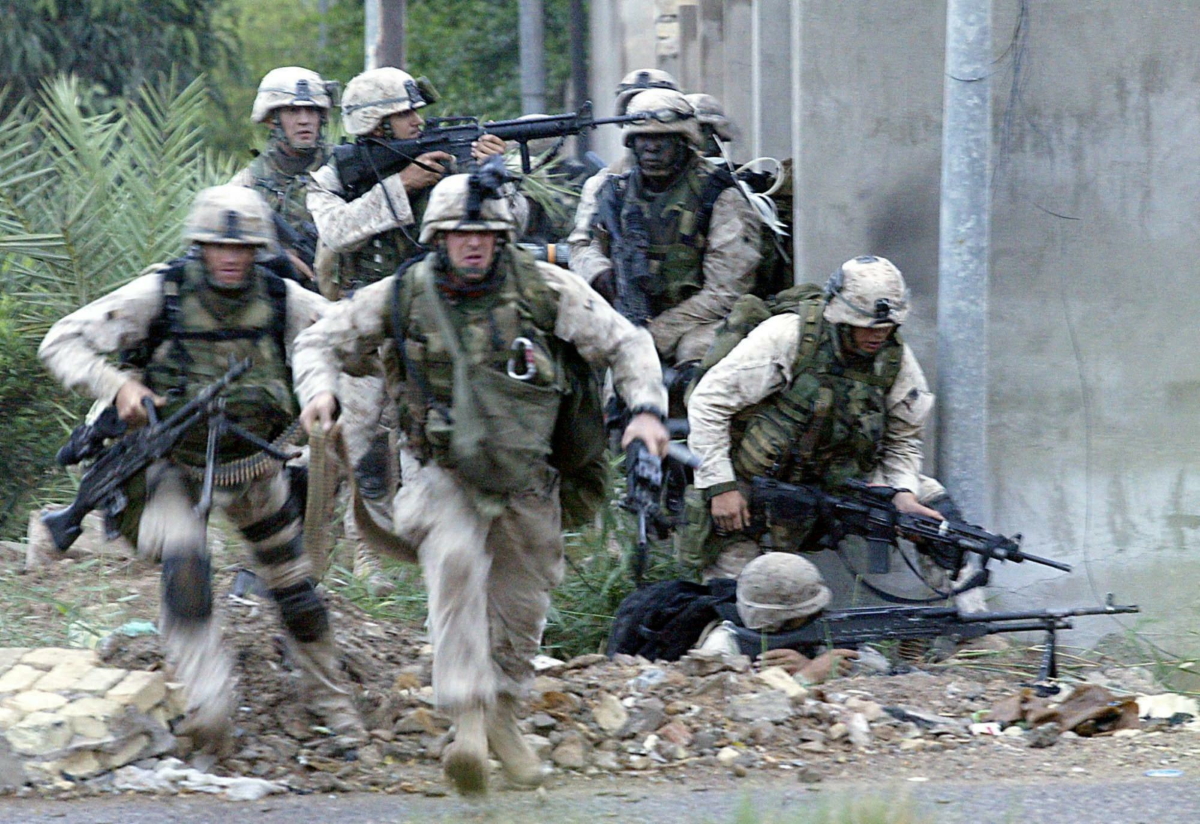
US Marines cross a road in
Fallujah while others provide covering fire during Operation Phantom
Fury/Operation Al Fajr (New Dawn)."
|
Things drag on
The following year (October 2005) a national election was held for the
new Provisional Government … with the outraged Sunnis mostly boycotting
the election. The Shi’ites now controlled Iraq … enraging the Sunnis
even more. Thus the elections failed to bring democratic harmony
(“Iraqi Freedom” as Bush entitled the whole enterprise) to Iraq … but
only a deepening of the civil war.
Things only worsened in 2006, with the blowing up of one of Shi’ite
Islam’s holiest mosques, the al-Askari or Golden Dome Mosque in Samarra
… bringing al-Sadr and his Shi’ite death squads out to kill Sunnis …
including their clerics. Then when the announcement was made of a
partial American and British withdrawal, al-Sadr boasted this
development as his forces kicking out the imperialist invaders.
And for Bush’s Republican Party, things were looking grim as the
November elections approached. The results were that the Democrats now
became the majority party in the House and the Republicans were reduced
to a mere tie with the Democrats in the Senate … but with two
independent Senators tending to vote with the Democrats. Then a day
after the elections, Bush announced that Rumsfeld would be replaced by
CIA director Robert Gates. The Republicans were upset that this had not
been done before the elections … when it might have made the Republican
Party loss much smaller.
The 2007 "troop surge"
At the beginning of the new year (2007) a desperate Bush announced that
he was stopping the troop drawdown in Iraq and was in fact sending an
additional 20,000 troops to Iraq to hit Iraqi insurgents hard and
retake the villages lost to them. He was also relaxing the
anti-Ba'athist policy and diverting Iraqi funding in the direction of
new reconstruction and jobs in Iraq. Democrats in Congress were
outraged and supported a resolution (non-binding however) disapproving
Bush's "troop surge." Nonetheless, the surge worked, villages were
retaken and even al-Sadr had become more cooperative. And by the end of
the year the level of violence in Iraq had subsided considerably.
Finally, in the last months of his presidency (late 2008), he announced
the beginning of a new round of troop withdrawals from Iraq. |
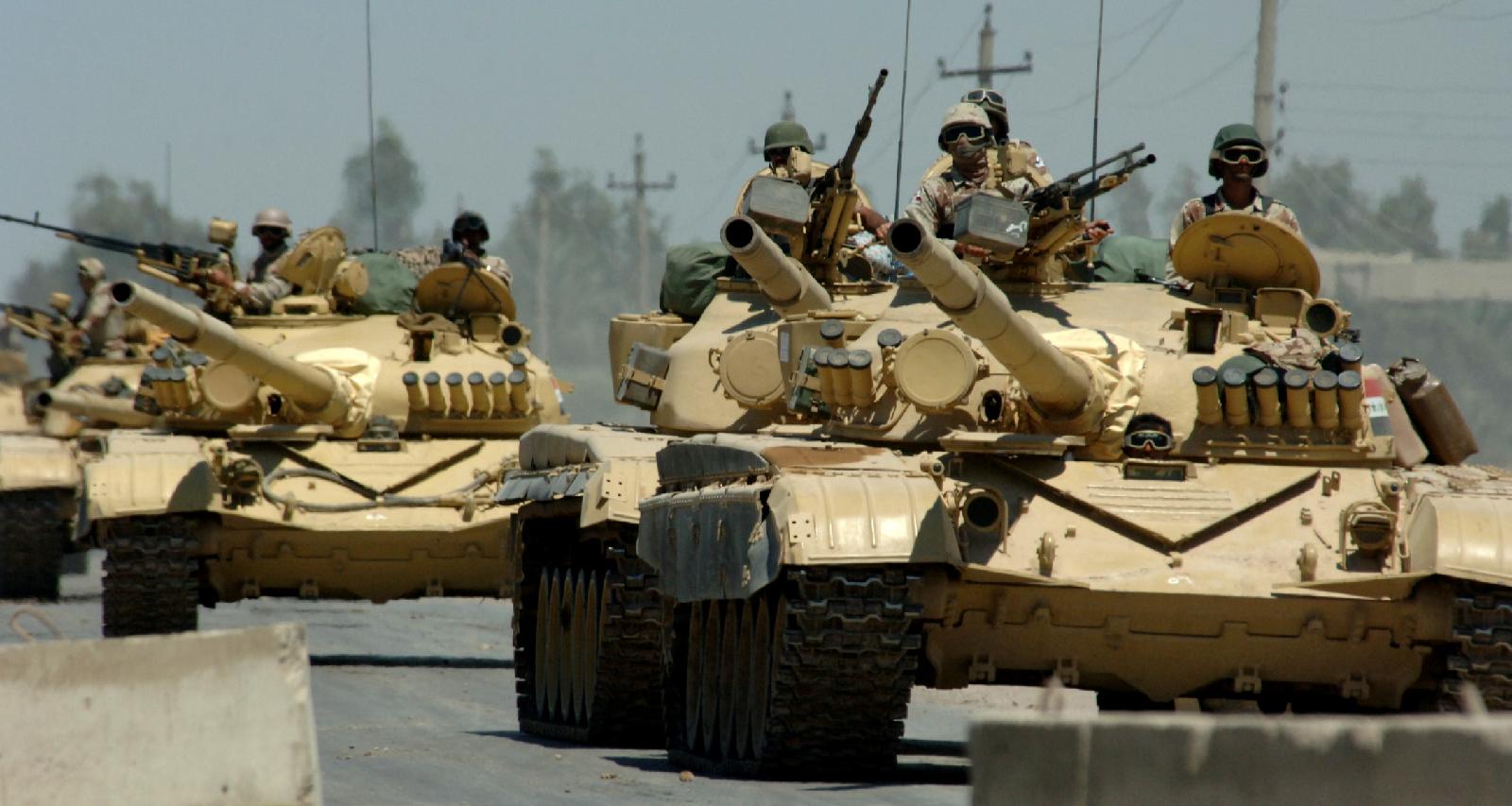
Iraqi Soviet-built T-72 tanks
assigned to the Iraqi Army 9th Mechanized Division drive through a checkpoint
near Forward Operating Base Camp Taji, Iraq - 18 May 2006.
|
Blair resigns as British Prime Minister (2007)
Sadly for Blair, his alliance with Bush in this Iraqi affair proved to
be his undoing. In 1987, when he became British Prime Minister, he was
the youngest of the 20th century prime ministers, and the leader of the
Labour Party in the largest electoral victory in the party's history.
His popularity continued as he introduced a number of widely popular
and rather "centrist" social reforms … and his foreign policy moves
such as his intervention in Kosovo and Sierra Leone were also widely
appreciated. Thus he led his party in 2001 to a massive victory in the
national elections of that year.
But his popularity would begin to drop with his involvement in the
Iraqi mess. Thus he was reelected in 2005, but by a substantially
reduced margin … but even then gaining the support he did because at
the time his country was still doing very well economically. The next
year (2006), now suffering very low performance ratings, he announced
that he would be stepping down within a year … and did so the following
June. Sad.
|
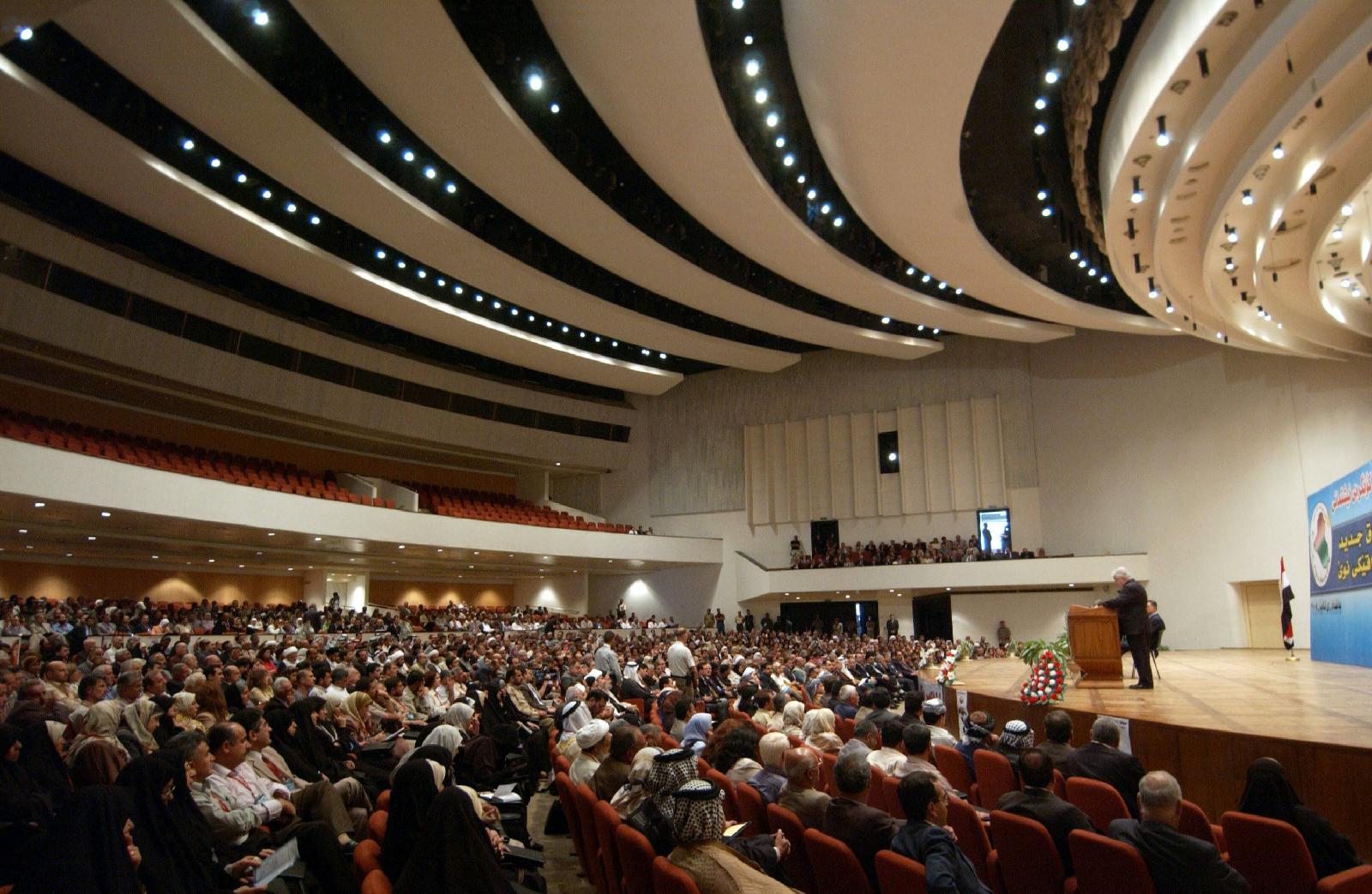
Inside of the Baghdad
Convention Center, where the Council of Representatives of Iraq meets.
This photo shows delegates
from all over Iraq convening for the Iraqi National Conference
- 30 December
2008

Go on to the next section: Mounting Domestic Problems
 Miles
H. Hodges Miles
H. Hodges
| | | | |


 The American elections of 2000 – Bush
The American elections of 2000 – Bush 9/11 (2001) – The cruel hand of Islamic
9/11 (2001) – The cruel hand of Islamic  Bush decides to take on Saddam's Iraq
Bush decides to take on Saddam's Iraq











 Pres. Bush being informed
by Chief of Staff Andy Card of the WTC tragedy
Pres. Bush being informed
by Chief of Staff Andy Card of the WTC tragedy























 Frankfurt,
Germany
Frankfurt,
Germany Munich, Germany
Munich, Germany




































































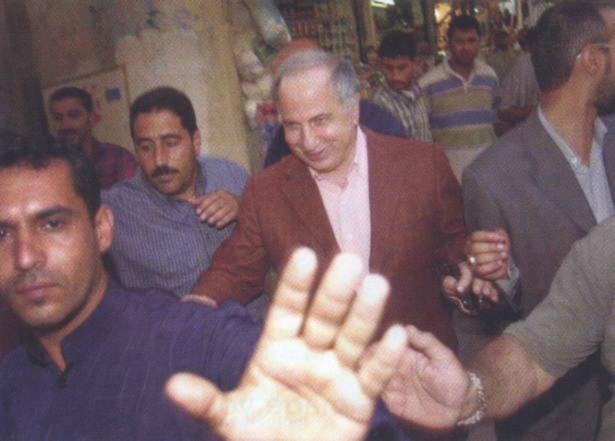
 Iraqis in Fallujah dragging
through the streets the charred body of a US security contractor
Iraqis in Fallujah dragging
through the streets the charred body of a US security contractor US and British soldiers being
held captive by al Zarqawi (the US troops were beheaded
in front of the camera)
US and British soldiers being
held captive by al Zarqawi (the US troops were beheaded
in front of the camera)








